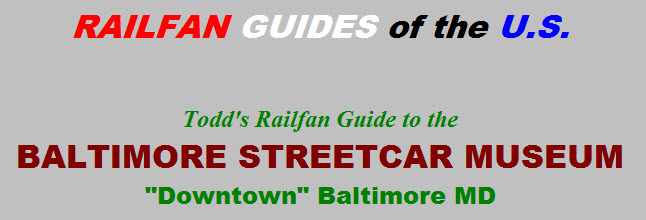

In General
Getting Here
Map
Complete Inventory
Pictures
"Group Photos"
Individual Photos
Pictures from 2008
Pictures from 2016
Misc Pictures
CSX Derailment
A Tour Up Falls Rd
Articles
In The Beginning
RAILFAN GUIDES HOME
RAILROAD SIGNALS HOME
Location / Name:
Northern Baltimore City MD
What's Here:
the Baltimore Streetcar Museum - America's only downtown streetcar museum
Data:
GPS Coordinates: 39.312280, -76.620761
Address: 1901 Falls Rd, Baltimore MD 21211
Phone: 410-547-0264
https://www.baltimorestreetcarmuseum.org/
Scanner Frequencies:
?
Access by train/transit:
via bus line #27 at North Avenue, and a little walking,
via Light Rail at the Mt Royal or North Ave station, and a little walking,
from the Amtrak/MARC Penn Station (and light rail), also by walking.
(If you do walk, make sure you have a buddy with you, as the neighborhood is not the best - wouldn't suggest it for families tho)
The Scoop:
The Baltimore Streetcar Museum became America's only downtown streetcar museum by chance, it wasn't originally planned that way. Back in the early 60's, a group of streetcar fans in a precursor to the BSM had planned for a museum site in Baltimore County, along the old right-of-way for the Northern Central's (PRR) Greenspring Branch at Lake Roland. They had put in some track and the framework for a carbarn.... until.... this mean ole nasty guy, Mr. Guntrum, living up on L'Hirondelle Club Road, got wind of it and had it squashed - he knew people in the Baltimore County government - I think he was a lawyer (how do I know, I lived a few doors down from him :-)..... more below at the very bottom of the page.
So, in 1968, the BSM acquired the rights to some former Ma & Pa RR property along Falls Road in the city, just north of PRR's Penn Station. The city, for a sum of something like a dollar a year, gave the BSM a lease on the property for 99 years. The city also built the carbarn for the museum. The square pictures further down the page document some of the scenes at Lake Roland before and after the move to downtown.
In case you wonder where the number comes from on the motorman's and conductor's caps, the memberships in the museum are organized in this fashion: 1 thru 49 are original members from the precursor group - this section will never have any new members added to it; 50-99 are corporate memberships; and from 100 on up are the regular memberships where anyone can join. I joined in 1967 and have a membership number of 136.... they are way over 1000 today!
The streetcar collection used to be ALL Baltimore streetcars until maybe 2015?, when we acquired several PCC cars from SEPTA. They only cost $200, but it cost $2400 to get them moved down to Baltimore. Then we also acquired a NJT Newark PCC car. The BSM website, as of July 2015, does not contain a complete inventory of its equipment.
The workforce is ALL volunteer, and if you think you have some skill to contribute, please join -- us older folks are dying off quickly and in as little as ten years, there won't be enough people to have a museum! :-)
Cars run almost all year except for (starting in March 2015) January and February. Hours are in the afternoon 1pm till 5pm on Sundays, and they sometimes have special events and Saturdays.
The museum collection contains the last car to run in revenue service in Baltimore back in 1963, PCC car #7407. Another car was the last one to pull into the carbarn, but John Engleman was there, and had the operator pull back out of the carbarn onto the mainline, and then back into the carbarn so it could capture the title. :-)
Way back in the early days, the museum was running a contest to name the then new newsletter. Myself and Rob Catlin (#144 I believe) submitted the winning name, "The Live Wire", and it was announced in issue II-2 of the newsletter.
In comparison to some of the other streetcar museums in the country which have excellent presentations, the inside displays are pretty mundane. This stems from the fact that the museum also uses the space for meetings. I suggested years ago that they expand the second floor for the meeting room, add soundproofing, and make a kick-ass display area on the lower floor - and so it goes... oh well......
Acknowledgements:
Thanks to John Engleman for his help with this page
Suzy Kopf
Websites and other additional information sources of interest for the area:
As of March 1st, 2018, The BSM has their "new" website up and going: https://www.baltimorestreetcarmuseum.org/
A guide to 7303's Restoration
The Baltimore Streetcar Museum is one of the few museums that exists in a "downtown" setting, the only other one I'm aware of is the Minnesota Streetcar Museum in Minneapolis.
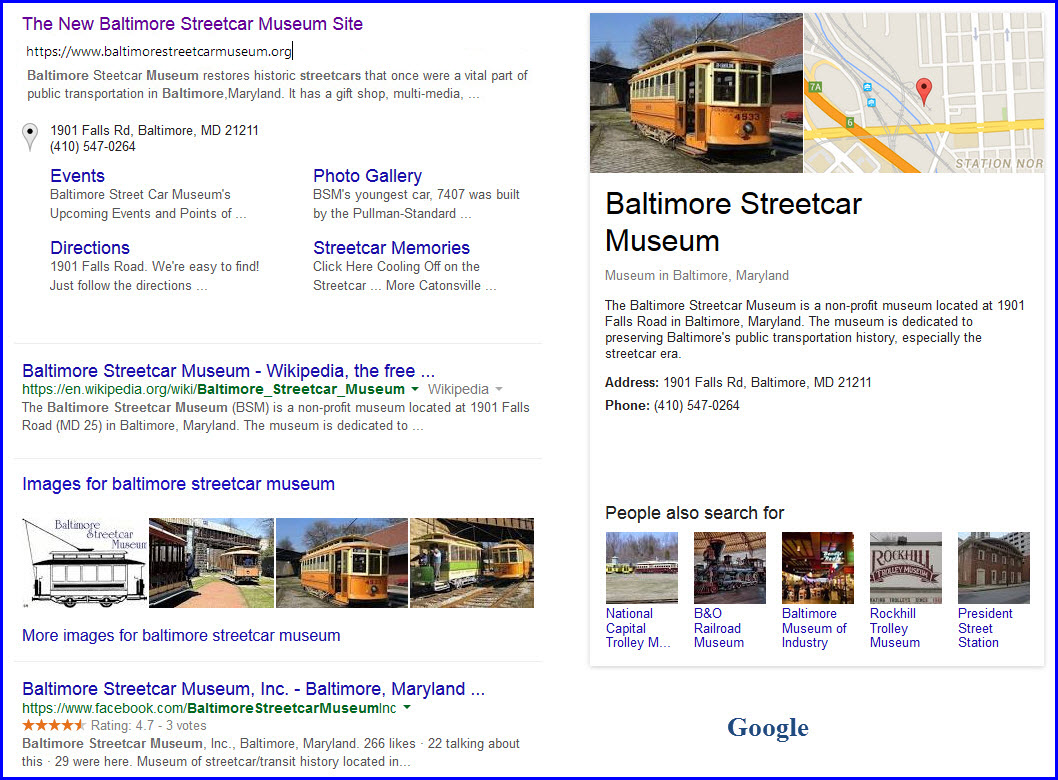
If you're "coming down" I-83, the JFX - Jones Falls Expressway from the north of Baltimore, such as the Towson area, or I-83 coming down from York or Harrisburg PA, take exit 6, North Avenue. At the end of the ramp, take a left onto North Ave, and go a few blocks till you can take a right onto Maryland Ave. You can take another right at either Trenton St (the yellow arrow) or Lafayette Ave (staying with the red). Trenton isn't always a good choice, for it is more of an alley than a street, and it might be clogged up. Either one ends at Falls Road, and you should take a right. Falls Road goes under both Howard St and North Ave.
If you're coming up from downtown (black line), Charles Street is probably the best bet. When you get to Lafayette, hang a left, and join the red route.
From the west, you could come in via the Beltway, I-95, I-395, Conway St, and then Charles St, or, you could come in via Cooks Lane (off the end of I-70), Edmonston Ave, West Franklin, West Mulberry St, and when you hit Charles St, hang a left.
From the east side of Baltimore, streets like Pulaski Hwy/Orleans St, Baltimore St, or Madison St will get you to Charles St.
If you are coming to the museum by way of public transportation, there are roughly 3 choices, listed at the top of the page. Be careful when you walk on North Ave and Charles St, they ARE NOT the best neighborhoods in the world - use common sense and make sure you have a buddy or two with you.
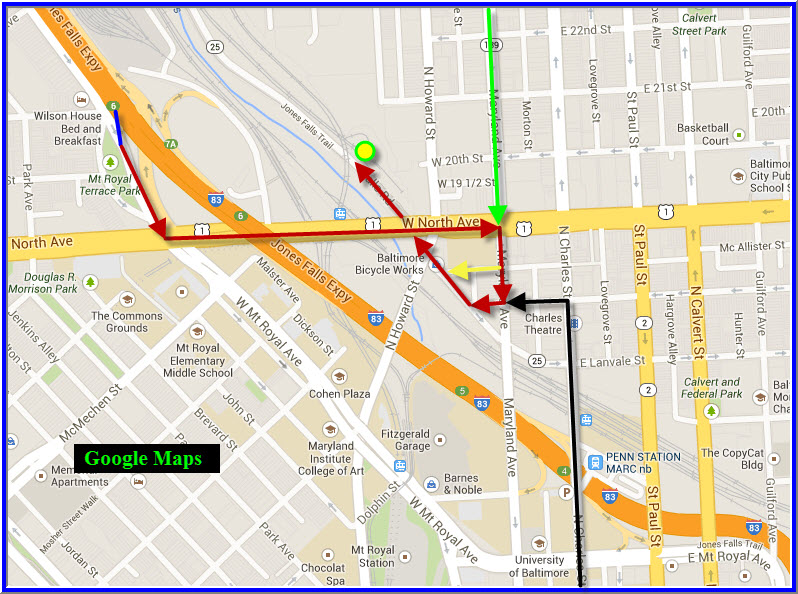

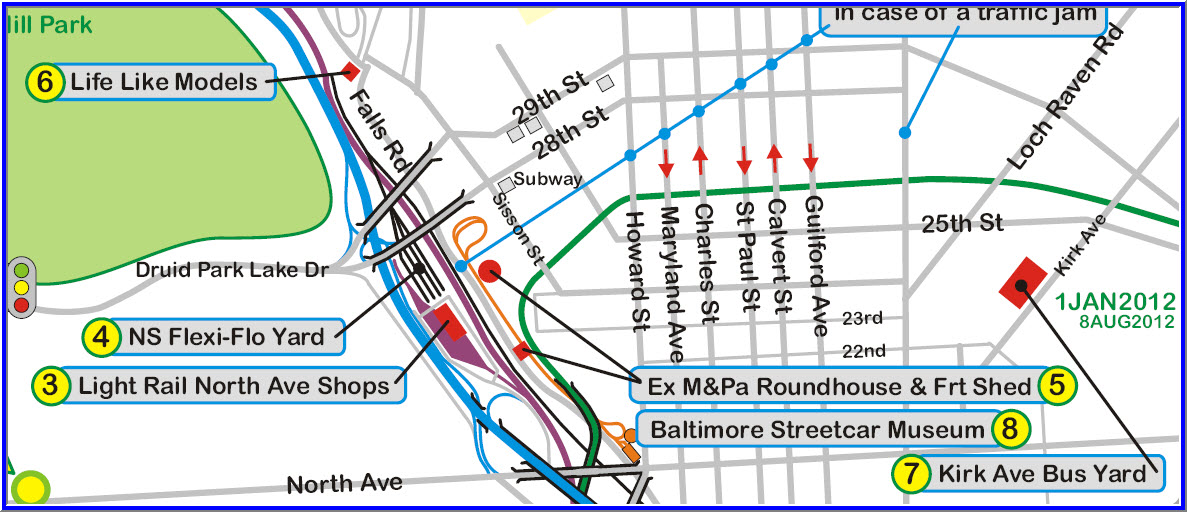
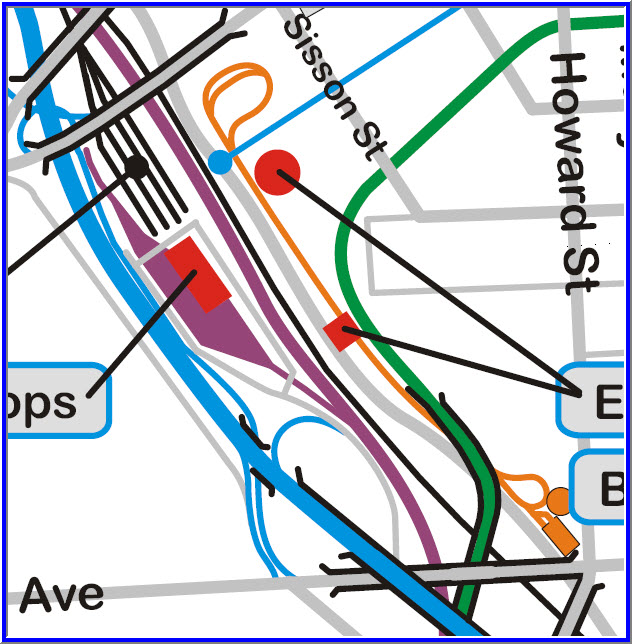
The two maps above are sections of my
Baltimore Map 4, the complete guide for this area of Baltimore can be found
here
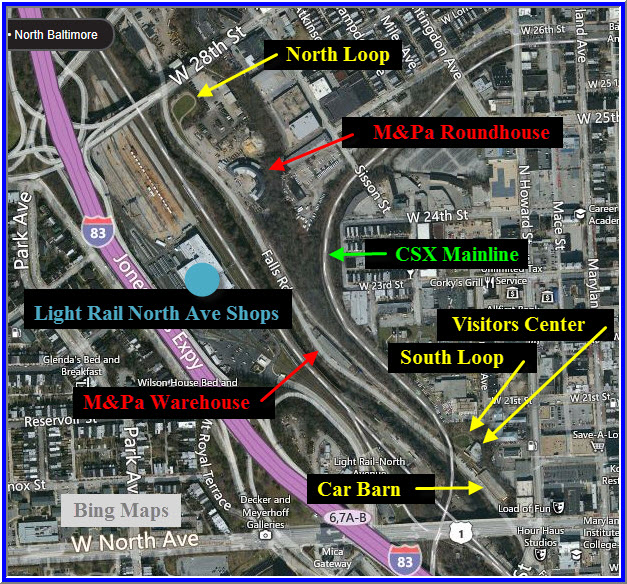
Complete Inventory List of BSM Assets: Past, Present & Parts
List compiled with the help of John Engleman
Descriptions in italics come from the BSM website.......
#25 Pictures
Horse Car - Built 1859 by built by Poole & Hunt right up the road in
Woodbury. Unrestored body incapable of being restored. Shell only.
#26
St. Louis Car. Co. 1949 PCC. Originally built for Minneapolis/St. Paul.
Sold to Newark, N.J. Stored outside at BSM. Vandalized and weather damaged.
Plans are to get it running. Has problems unsolvable by BSM electricians
- so far, this was in 2015. In 2017, the car will run, but can't be
stopped -- the GE electrical equipment won't talk to the Westinghouse trucks
and operate the brakes (it could be the other way around, not sure).
#129
Horse Car - Built in 1865, it was a home built by Baltimore City Passenger
Railway in 1875. Historical item kept by BTC (Baltimore Transit Company) for parades, etc.
On hard rubber wheels. Planned to revert to steel wheels someday.
Car 129 was built around 1880 by the John Stephenson Company for the Baltimore City Passenger
Railway Company. Weighing a mere 4,000 pounds, the car probably saw its last years of service, into
the early 1900's, on the Harford Road line to Hall's Spring (near the present Argonne Drive and
Harford Road). After the car was retired from service, the United Railways and Electric Company refurbished
the car and used it for many parades along routes with streetcar tracks. In later years, the
Baltimore Transit Company again rebuilt the car with rubber tires so that it could be used anywhere, still with
horses. The car left the Baltimore area by the late 1940's but happily, it was returned to the
Baltimore Streetcar Museum where it is still used occasionally for parades.
#264
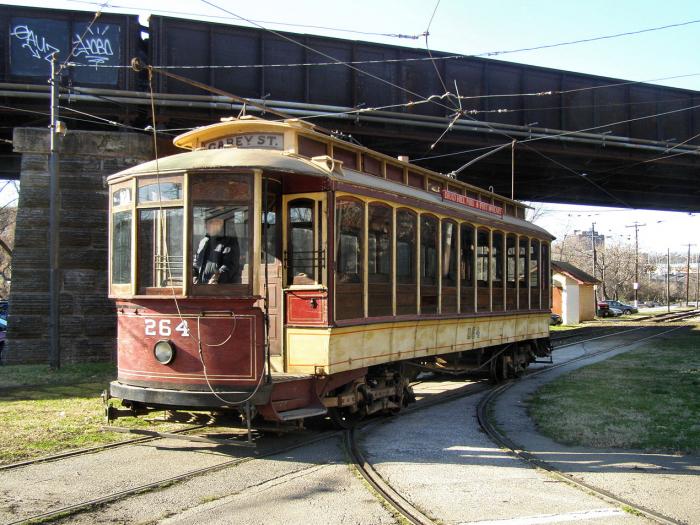 #264
#264
Brownell Car Co. double truck convertible car, built 1900. Operating
but showing age badly. It was the very first car restored by the BSM
in 1968.
#417
Horse Car, to Cable Car trailer, to Electric Car. Built in 1884, it's
a home built by Baltimore City Passenger Railway. (Supposedly) the oldest operating electric streetcar in the U.S.
Restored and operating.
#390
Newport News semi-convertible built 1918 by JG Brill as add on to Baltimore Red Rockets. Acquired by BSM
in 1978. Nothing ever done. Hope to return car to
a real museum in Hampton Roads Va. Negotiations underway.
#501
Auto Car overhead lines truck. Built 1940s. Exact date unknown.
Operable with work.
#554
Brownell Car Co. single truck open car. Built 1894. Currently under restoration.
Car 554 is a 9 bench open car built by the Brownell Car Company in 1896 for the Baltimore Traction Company.
This single truck car has flip over seats and pull down curtains.
#1050
Brownell Car Co. single truck "accelerator" car. Built 1896. Currently under restoration.
Car 1050 was built in May 1898 by the Brownell Car Company of St. Louis as part of an order of 73 cars
to replace cars that burned in the Irvington carhouse fire of 29 May 1898. The cars were
finished with cherry sashes and interior, red Wilton carpet seat covering, and a Tuscan Red/White
exterior paint scheme. They originally were assigned to the Roland Avenue line, #10 (50 cars), and
Gilmore Street, #1 (23 cars). By 1906, the cars in this order had been relegated to lighterlines.
By 1911, they were the replacements for the older cars that had covered jerkwater (branchline)
service. Fourteen cars were converted to one-man operation between 1916 and 1921 and served
until January 1927. Another 27 cars from this order were equipped with air brakes, demotorized, and used
as trailers starting in 1918. They were replaced by the 1921 Brill trailers and stored until 1926,
and then scrapped. The remaining cars were withdrawn from service and scrapped piecemeal between
1920 and 1929. Several cars were converted to utility service, several were placed in playgrounds, and
one was renumbered 2801 and assigned to the Safety Department, traveling the transit system displaying
bulletins for the information of motormen. It was renumbered 3651 in 1925 and renovated for display
at the 1929 Fair of the Electric Pony. It is presently being restored to its original number.
#1096
GMC TD4506 bus built in 1945. First GM diesel bus, serial number 001.
Very historical piece of equipment. Was operable when acquired, now in
outside storage deteriorating badly. Vandalized. Parts missing.
No distinct plans except talk.
#1164
JG Brill double truck open car built 1902. Operating but showing age.
It is the second car restored by the BSM.
#1298
Ford Transit Bus. Built in 1948. Never used by BTC. Sold to WMAR Channel 2 for
mobile TV studio and transmitting station. Stored off property awaiting decisions. In poor shape.
#1962
GMC "Fishtank" diesel transit bus, built in 1963. These were the buses that
replaced the streetcars. BSM acquired the bus from the Baltimore City
Police Dept., which used it as the "Officer Friendly" bus. Being restored
to as new condition by member Paul Sause and a few others. Off property.
#2035
GMC "Fishtank" diesel transit bus, also built in 1963. Parts bus for #1962.
It was an MTA classroom bus previously. It will most likely be disposed of eventually. Off property.
#2078
Pullman-Standard trackless trolley. Built in 1940. Very historical piece of equipment.
It is the ONLY Baltimore trackless trolley saved. BSM management seems to care less.
Unloved by anyone capable of restoration. Shoehorned into carhouse,
with planned banishment to open storage where it will rot.
#2160
St. Louis Car Co. 1948 Philadelphia PCC. Car sold for planned Lancaster streetcar line
(which is now dead). Only electrical equipment still owned by BSM.
Stored under cover in Pa.
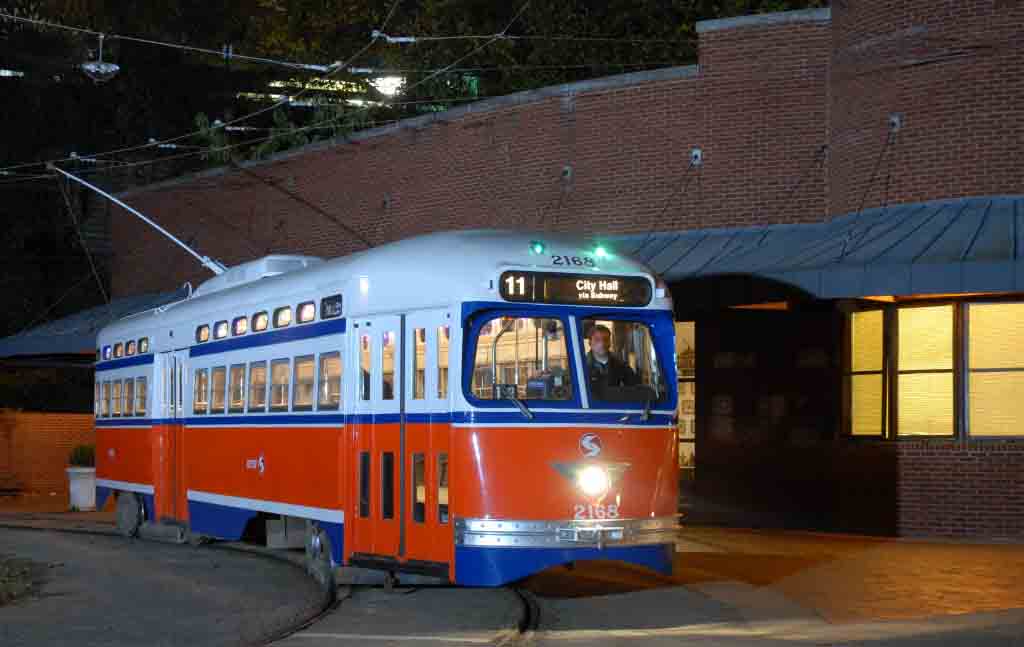 #2168
#2168
St. Louis Car Co. 1948 Philadelphia PCC restored as SEPTA Gulf Oil era car. Operating.
 #2187
#2187
#2187
#2187
St. Louis Car Co. 1948 Philadelphia PCC converted to overhead line car. Inoperable due to
negligence. Disposition in question, BSM management wants to scrap it. Stored outside at BSM, being vandalized and
damaged by the weather.
#2647
St. Louis Car Co. 1942 Philadelphia PCC. Body scrapped. Only electrical equipment, trucks, and floor still intact.
Electrical equipment and trucks planned to go under 7303.
#2728
#2728 still at the Elmwood Depot in Philly
St. Louis Car Co. 1947 Philadelphia PCC. Car donated by Todd Sestero.
See comment for 2160. Sold for money to a group in Lancaster, their project went no-where.
#2799
St. Louis Car Co. 1947 Philadelphia PCC. See comment for 2160
(2160, 2728, and 2799 were bought strictly to save them from the SEPTA
scrappers. This succeeded as the cars are still intact for some future use. Their sale did help BSM immensely financially at a time when finances were
very tight.
#3612
Single truck only from this car. No car.
#3715
Double truck crane hoist car. Built by Brill. Inoperable and needs much work. Acquired from Branford where it was running.
#3720
Speeder.
#3828
Closed car match for open car 1164. Restoration in planning stage. Movable under own power but not operating.
#4533
Single truck safety car. Built by JG Brill in 1904. Converted to air in 1924. Converted to
a test car in 1940. Restored as 1924 version. In operation.
#4662
Same as 4533 but never converted. Inoperable, but awaiting eventual restoration.
#4801
JG Brill Railess Vehicle. Built in 1922. Box shell only. Stored off property. No firm plans.
#6119
JG Brill "Peter Witt" car. Built in 1930. Restored and operating.
Car 6119, seen at the museum's 28th street loop, is one of 150 "Baltimore" cars ordered
by the United Railways and Electric Company These cars are called Peter Witt cars after the transit
designer who promoted the front entrance, center exit car with a conductor's station located just
forward of the center doors... This allowed fast loading of passengers during rush hours. Due
to the Great Depression economies, all the Witts were converted to one-man cars. The total order of
Baltimore Witts was 150, 100 from J.G. Brill and the balance from the Cincinatti Car Company. Car 6119
was built by Brill. Restored during the 1980's. This car design was used to collect data
used in designing the PCC. Although designed as a two-man car, it served its entire life in Baltimore as a
one-man car.
#7059
JG Brill trailer body (or what's left of it). Built in the 1910's. Body acquired years ago
with an outside chance of restoring it. It had been abandoned the in weeds.
#7303
St. Louis Car Co. 1936 PCC. Built for San Diego. Then went to El Paso. Then to
a real estate office in N.M. Purchased by the BSM through a donation for eventual
conversion into a "replica" of BTC PCC 7303. Work is in progress. Much work has been done on it.
Not officially part of the museum's collection. As of the summer of
2018, a small group is trying to get it to become part of the collection,
and it is starting to be worked on.
#7329
Pullman-Standard 1939 PCC. We only had the body, but it has been since scrapped and is gone.
#7350
Built by Pullman-Standard. 1941 PCC. Body only. Abandoned in place up in Hereford, Baltimore County.
Plans were proposed around 2000 to recover the shell from Hereford, but no-one could agree on how to move it, or what to do with it once we got it.
#7407
Built by Pullman-Standard. 1944 PCC. Pride of the Museum fleet. Last streetcar to run in Baltimore.
Saved from scrap by John Engleman.
Totally restored by Gov. Schaeffer and the MTA in 1990. The car is in operating condition.
7407 was built by the Pullman-Standard Car Manufacturing Company in 1944 for the Baltimore Transit Company.
It was one of the last streetcars ordered for Baltimore until the
MTA bought the new light rail cars. Since this car was built during the Second World War, the stanchions
are painted instead of chrome coated. This car represented the height of streetcar development
in the world when it was built and has the same general performance characteristics as the modern light
rail cars. This car was rebuilt in the early 1990's and is painted in its original color scheme
of cream, Alexandria blue, and orange. The original paint scheme of Baltimore's PCC cars was the result
of a student competition circa 1936 at the Baltimore Institute of Art.
#5246
Newark N.J. double truck snow sweeper. Ex-Toronto, ex-Rochester. Owned by a museum in New Jersey. BSM storing it.
If that museum does not collect the car within 5 years from the date we
started storing it, we get it. It is an almost duplicate of
Baltimore's #3239 snow sweeper.
#C-127
JG Brill double truck snow sweeper. Owned by Electric City Trolley Museum. BSM is also storing this one.
#C-145
JG Brill double truck Philadelphia snow sweeper. Built 1917. Operating.
On the property but not owned by BSM:
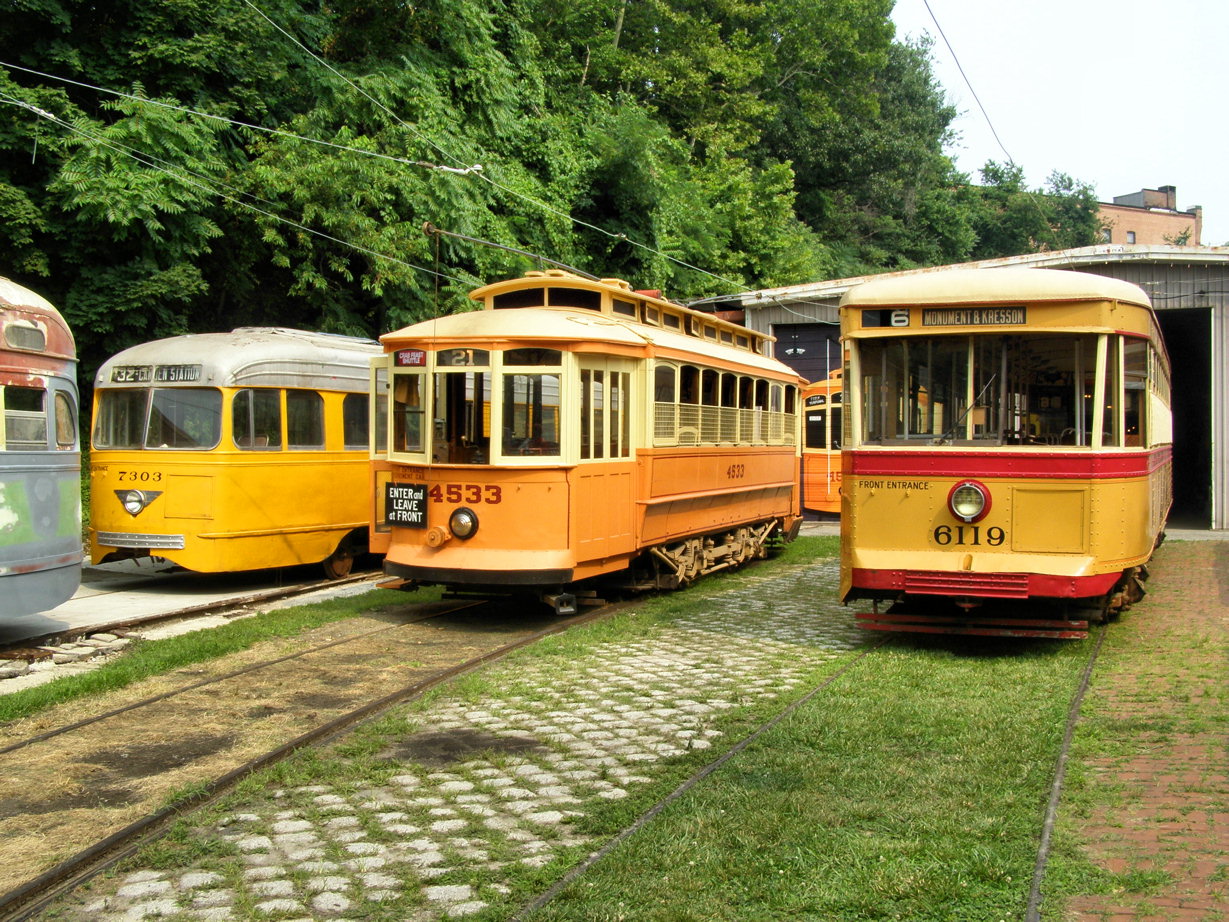
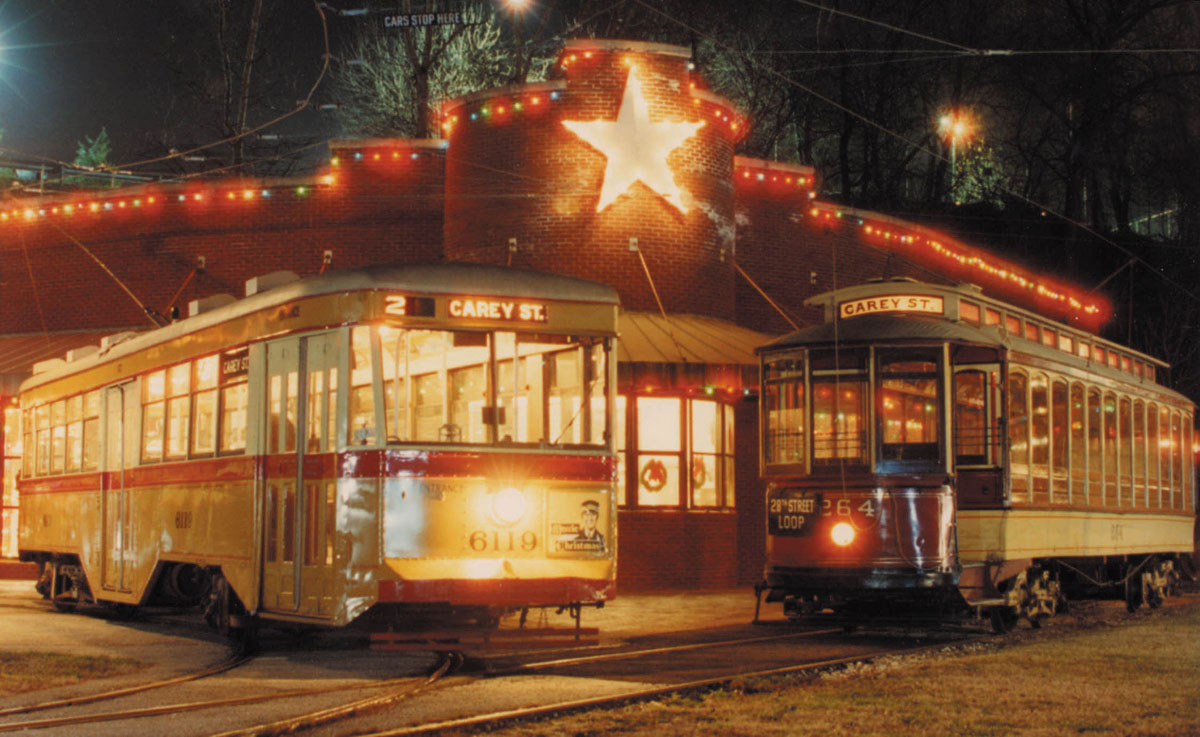
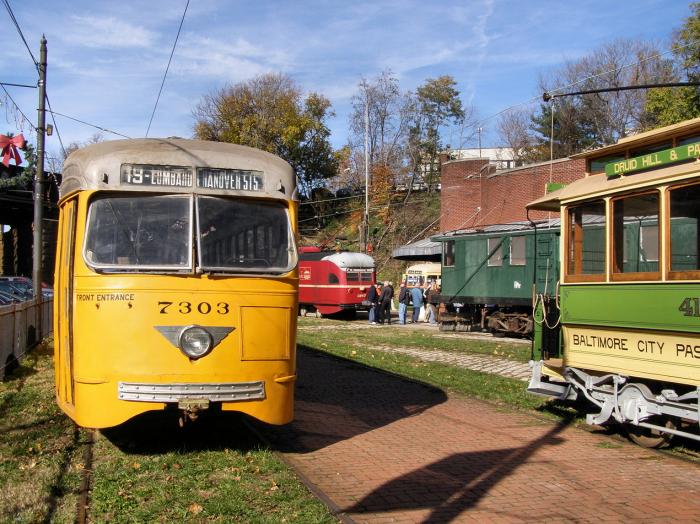
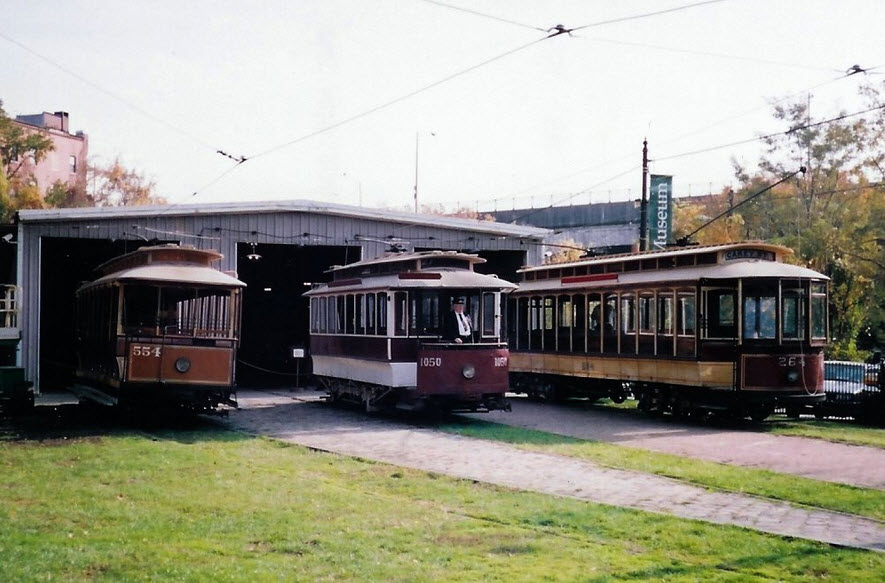
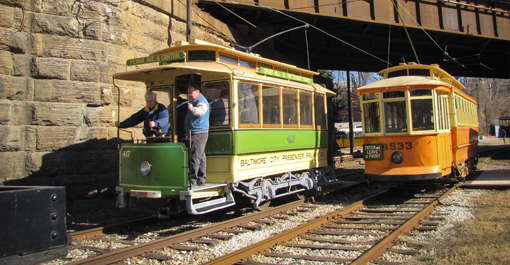
#26
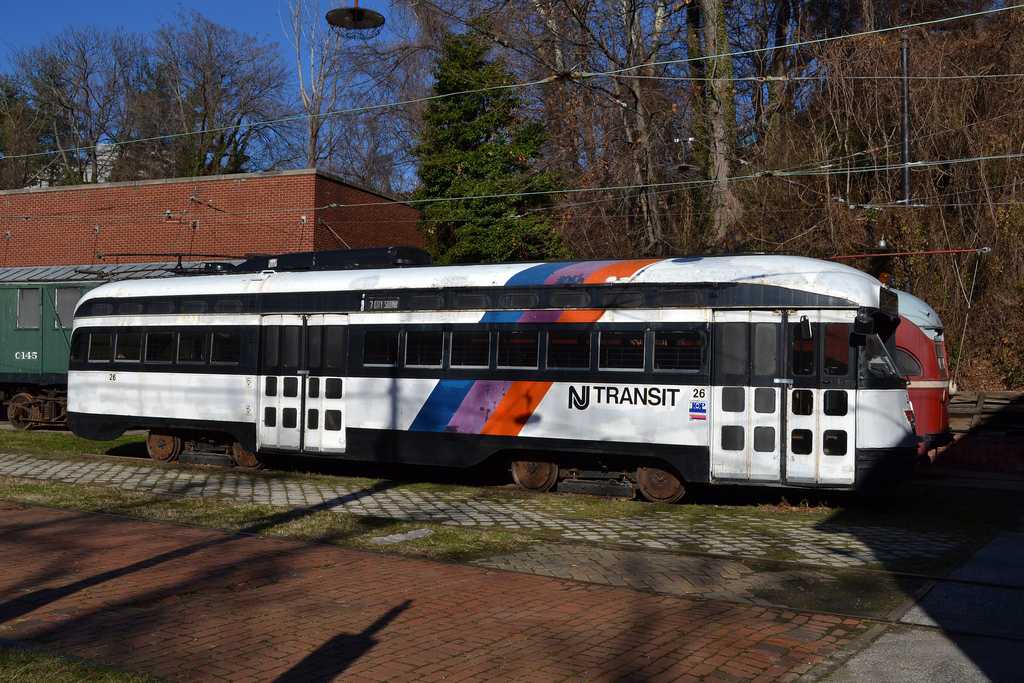
#417

#554
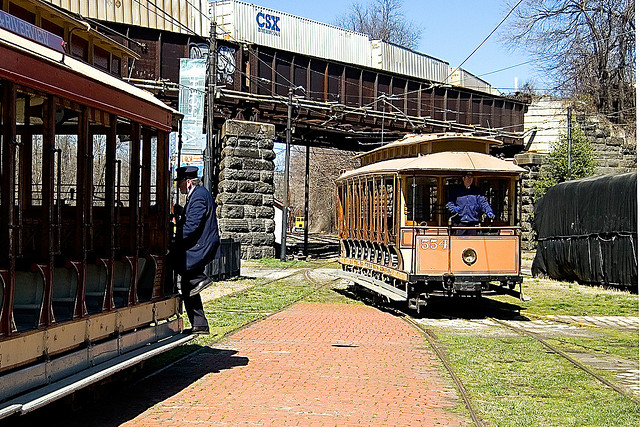
#6119
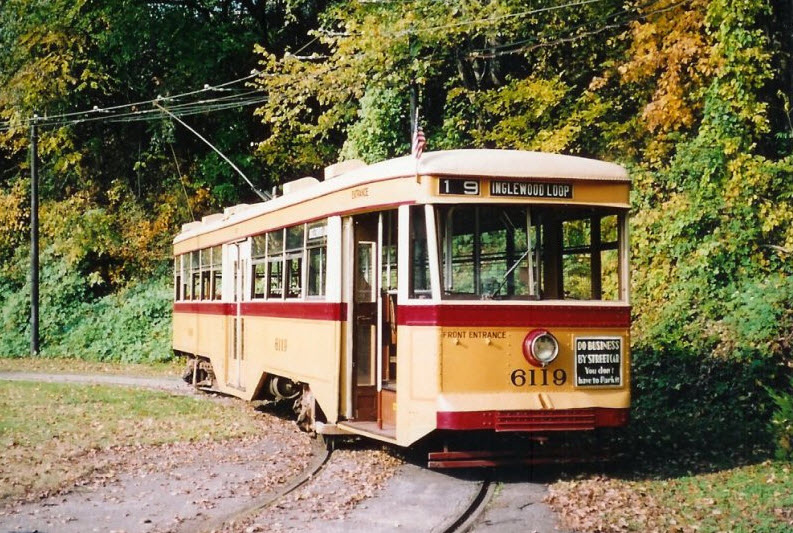
#2187
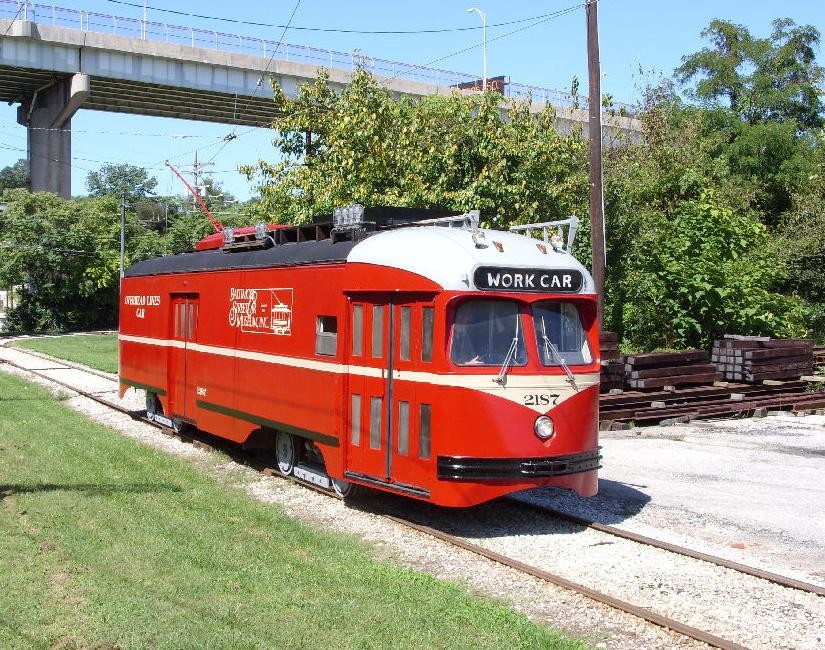
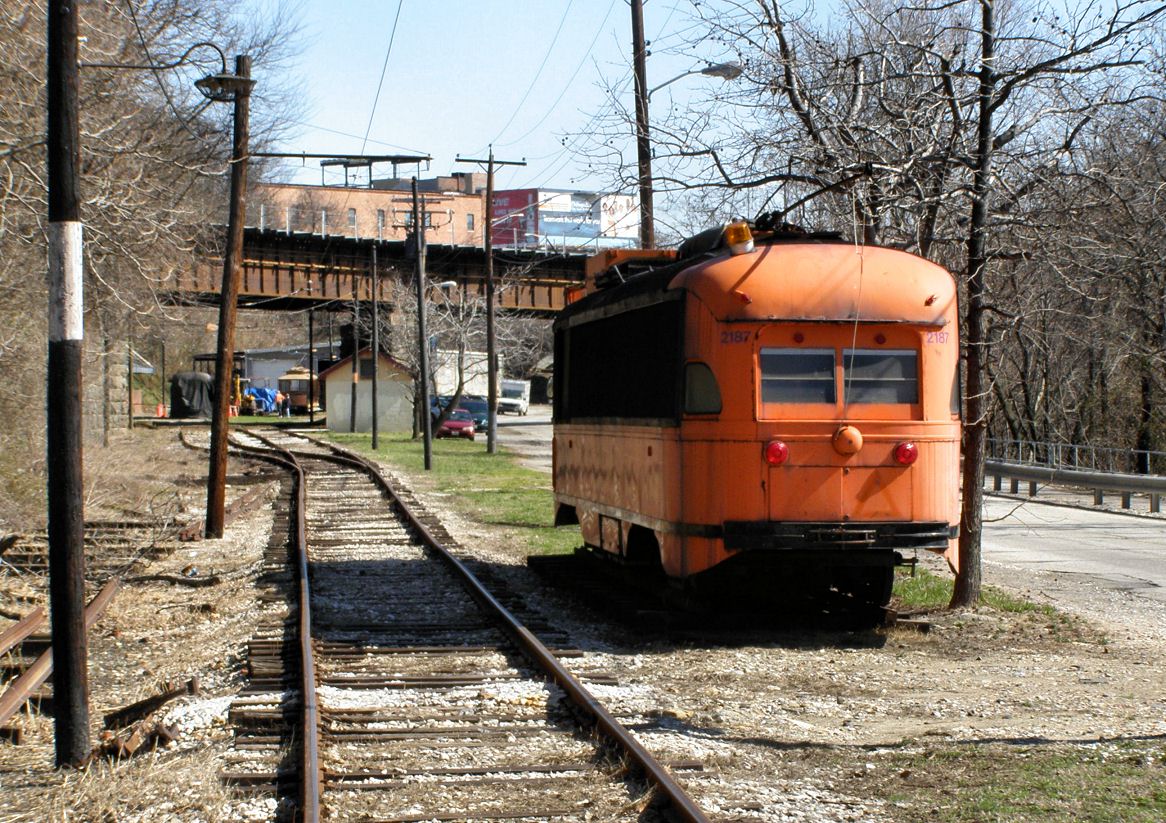
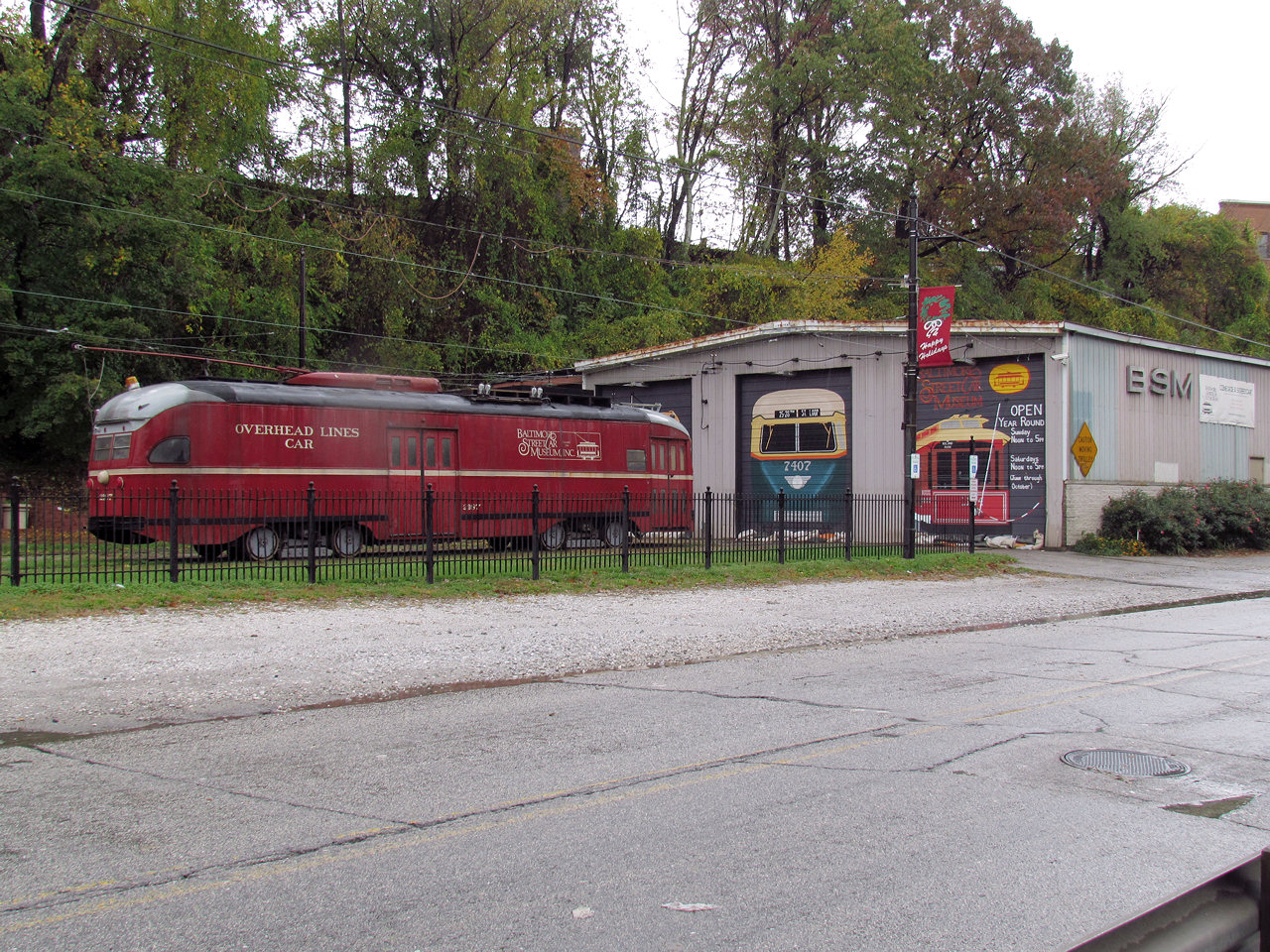
These are my own pictures.....
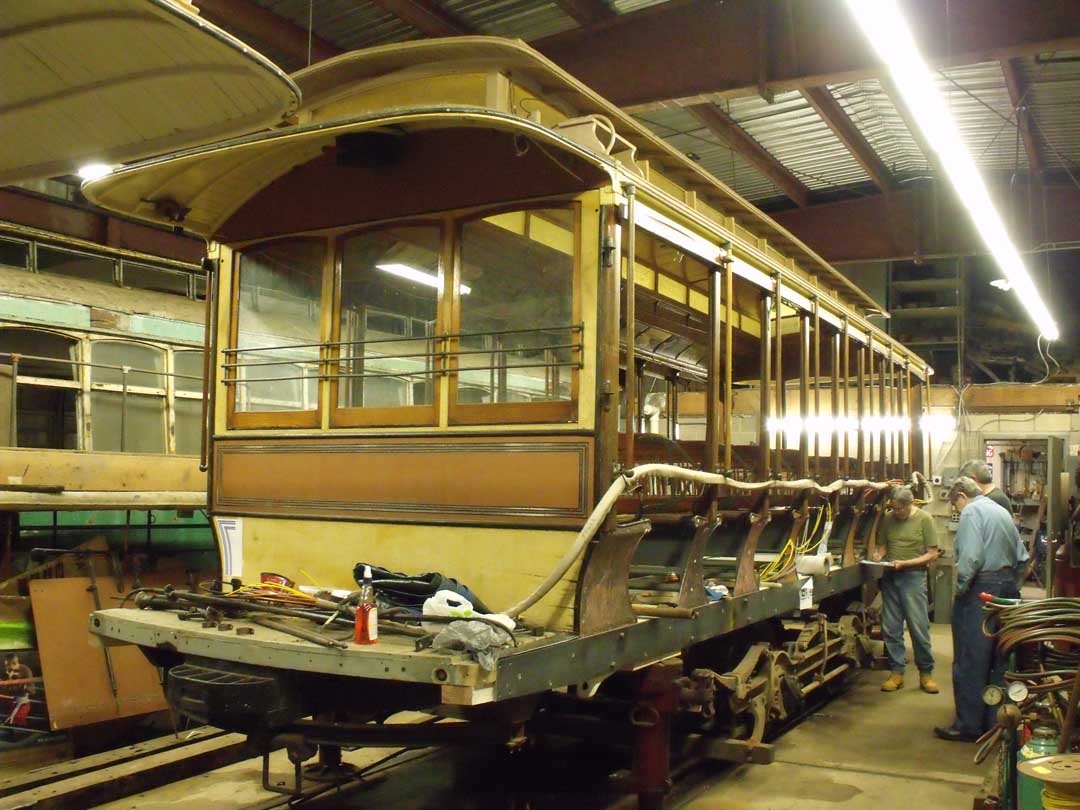
Sign on the substation, dedicated to member #1, George F. Nixon
1164, 4533, and the sweeper at the visitors center
New trackwork at the carbarn and visitors center
Trackless Trolley #2078 squeezed into the carbarn
#554 being worked on in the carbarn
#4533 leaving the visitors center
On March 15th, 2019, a CSX train derailed on the curve over the museum.
It destroyed the sub-station.
For additional pictures and information, I have whole page for the wreck here:
https://www.railfanguides.us/baltimore/CSXBSMderail/index.htm
The sub-station, dedicated to member #1, George F. Nixon.
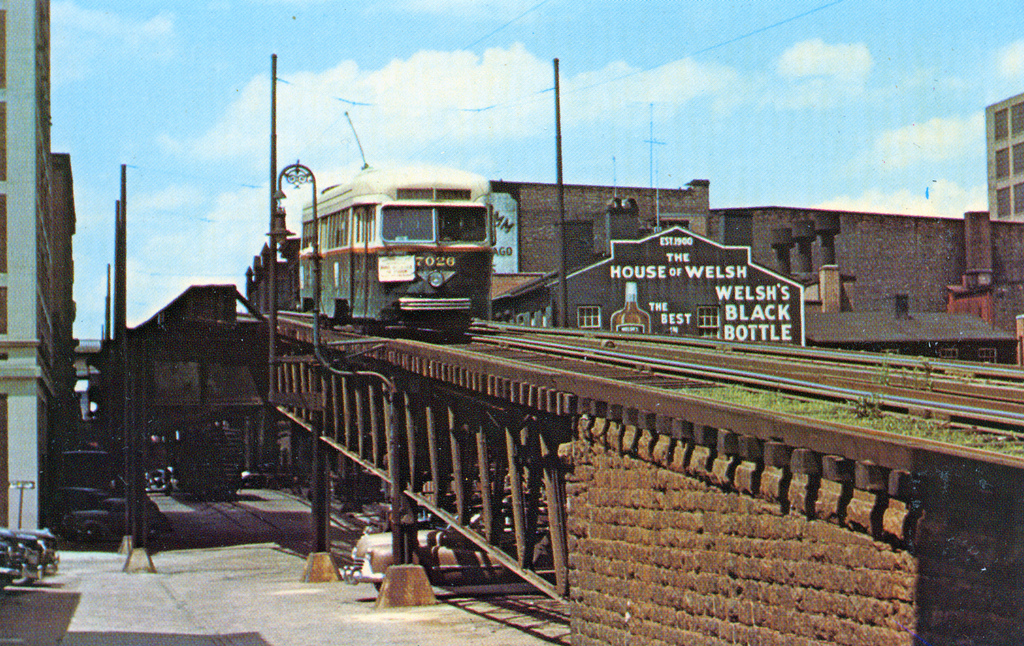
A PCC car rides over one of the few elevated sections of streetcar trackage in Baltimore, near where the Ravens Stadium is today.
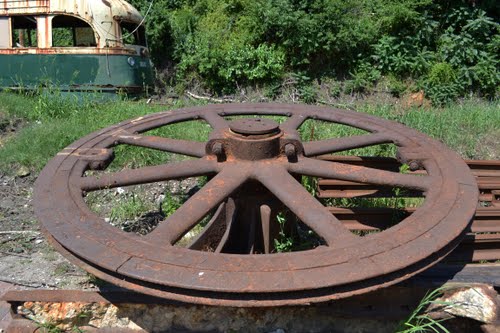
An underground cable car wheel from Paca Street on display at the M&Pa warehouse.
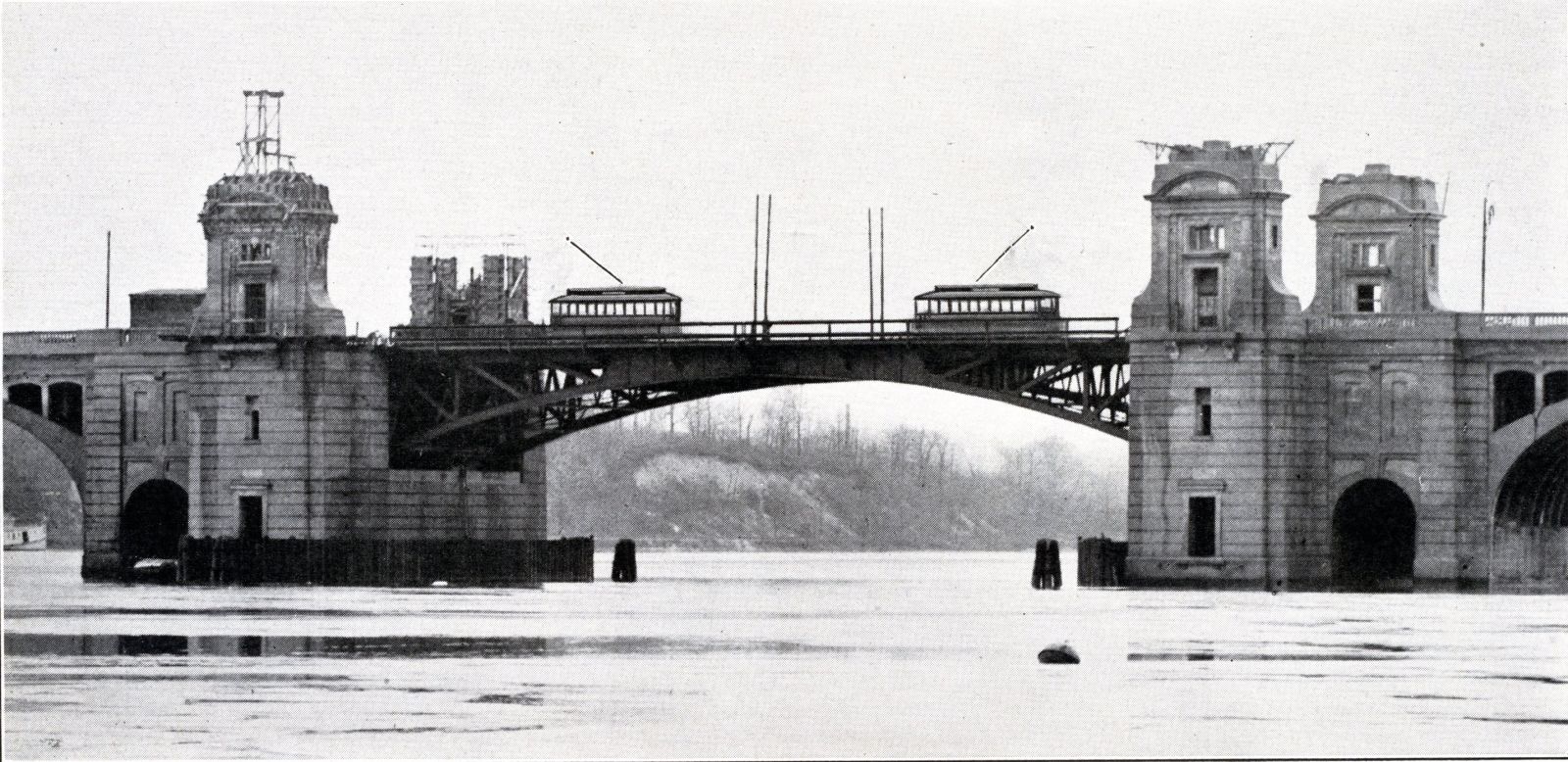
Streetcars on the Hanover Street bridge in south Baltimore.
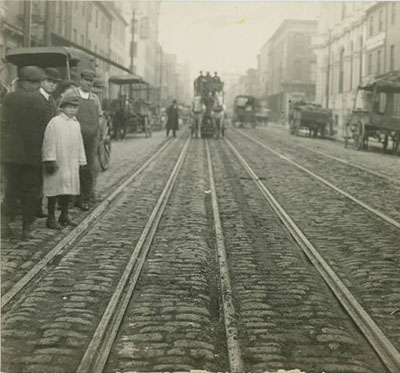
Don't have a clue where, but it looks like two streetcar tracks offset from each other......
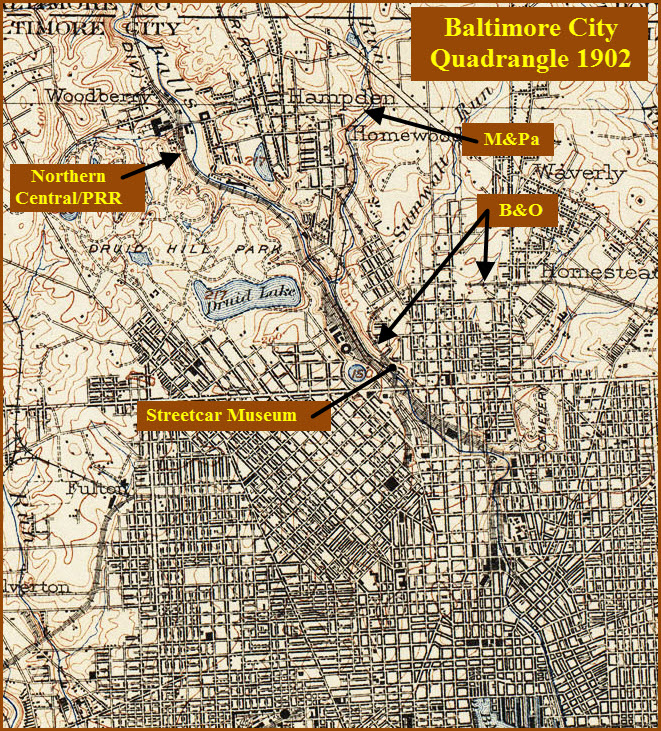
A 1902 USGS map of the area around where the streetcar museum is located now.
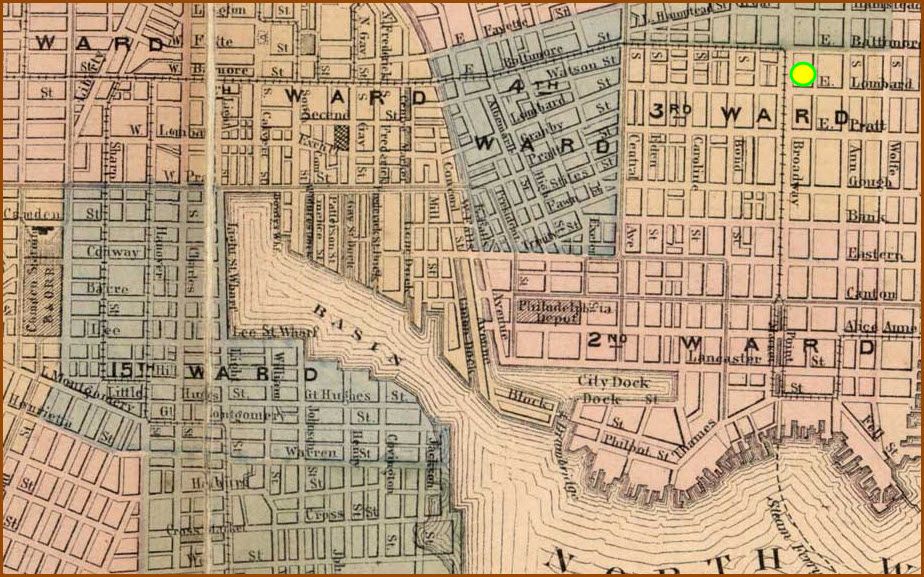
I used to own an 1845 rowhouse in Fells Point (at the dot), 7 S. Broadway, and it used to sit on
one of the first streetcar lines in the city - wish I had some pictures from that era! :-)
This is a tour going north on Falls Road, starting on the east side of Maryland Ave, where you can see Penn Station from the backside.
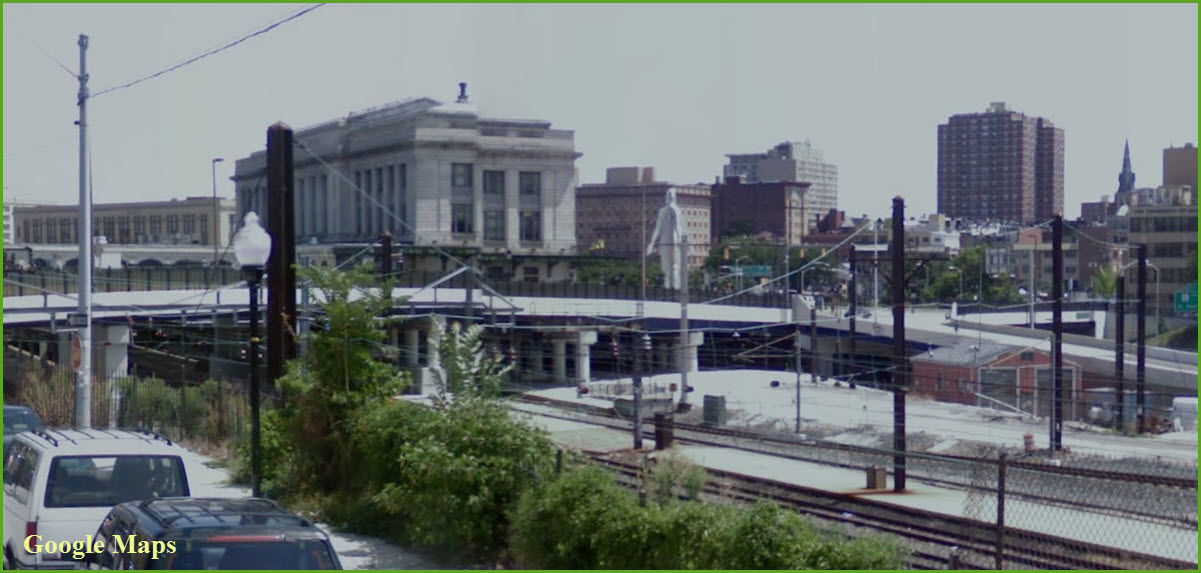
Once on the west side of Maryland Avenue, at the very "bottom" of Falls Road, you
have a fairly good vantage point to see Corridor trains, and the Light Rail going over I-83.
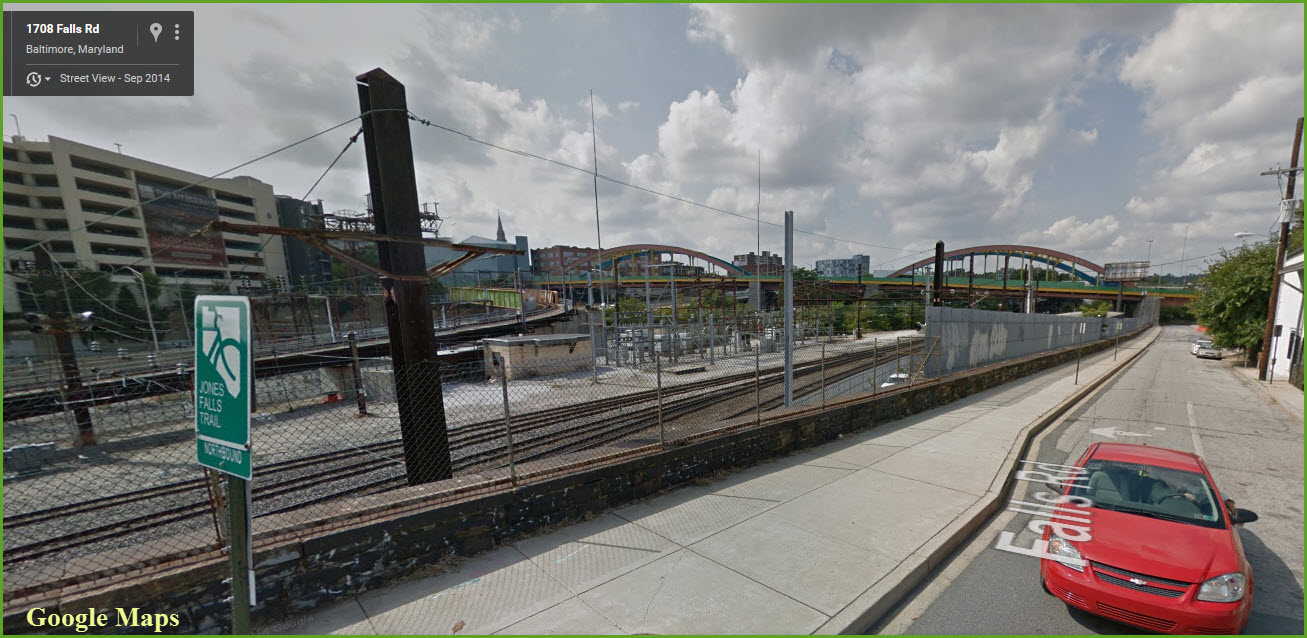
Next, we prepare to go under Howard Street and North Avenue. During the Ma & Pa days,
there was a station here, accessible from North Avenue. You can see the BSM carbarn in the distance.
Many of Baltimore's bridges over I-83 were brightly painted maybe 15 years ago or so like the Howard Street example here.
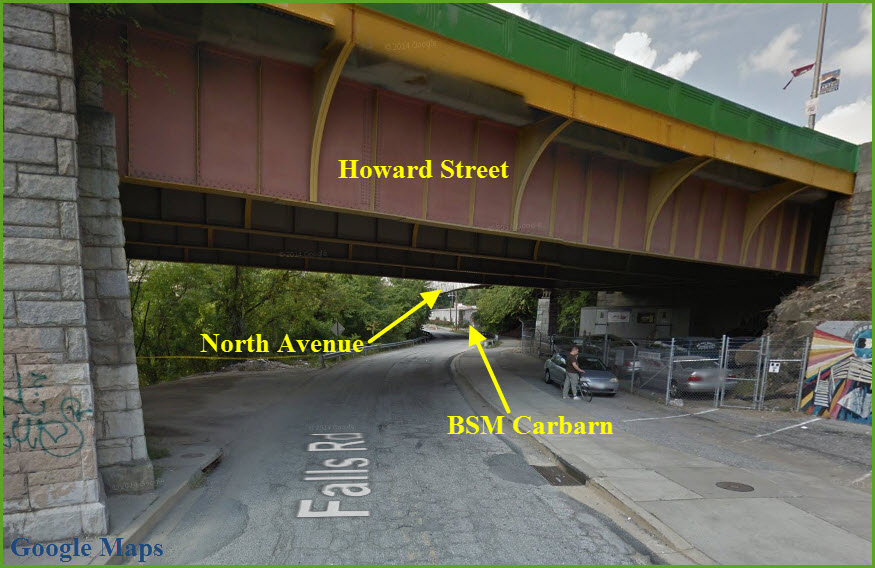
If you look over to your left just as you come out from underneath Howard Street, you can see
where the Northeast Corridor heads into B&P Tunnel. During
the summer it is difficult to get a good view through the brush.

Here we are between the North Avenue and Howard Street bridges.
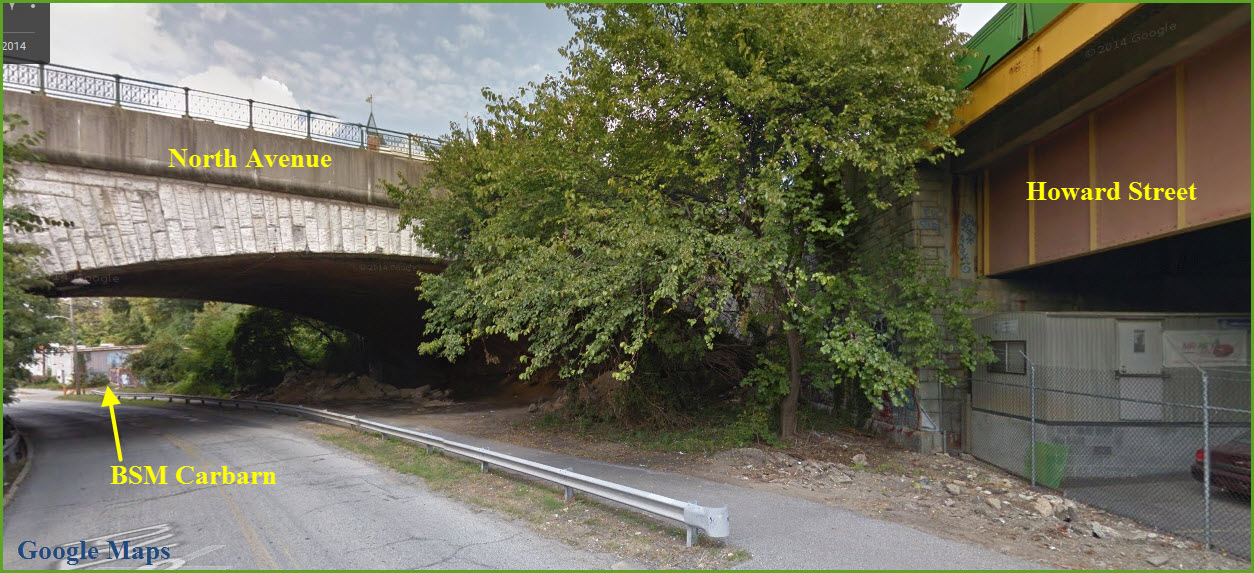
Looking back towards where we just came from, under North Avenue.
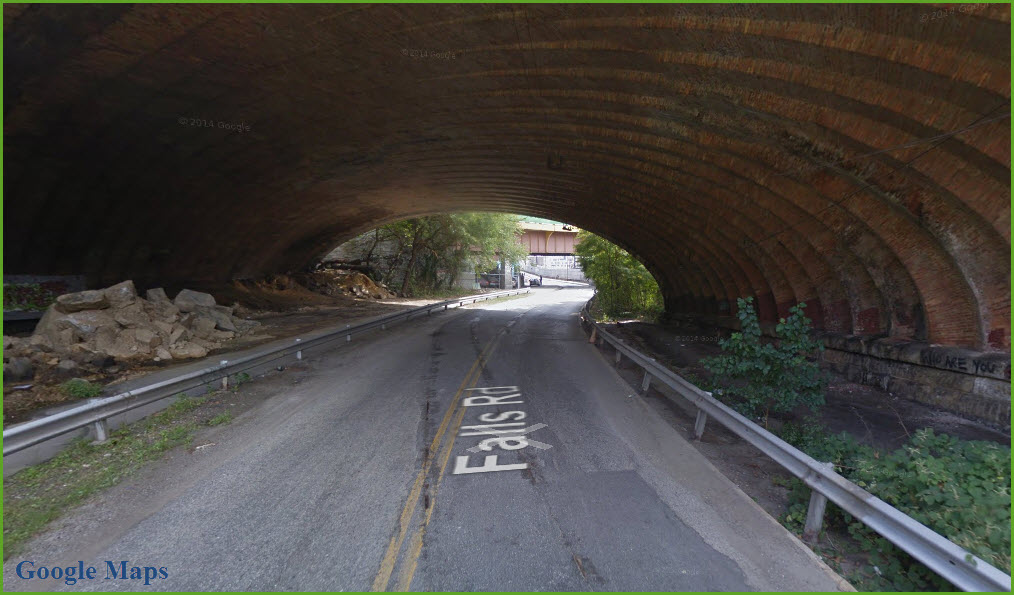
Coming out from underneath North Avenue, we approach the south end of the carbarn.
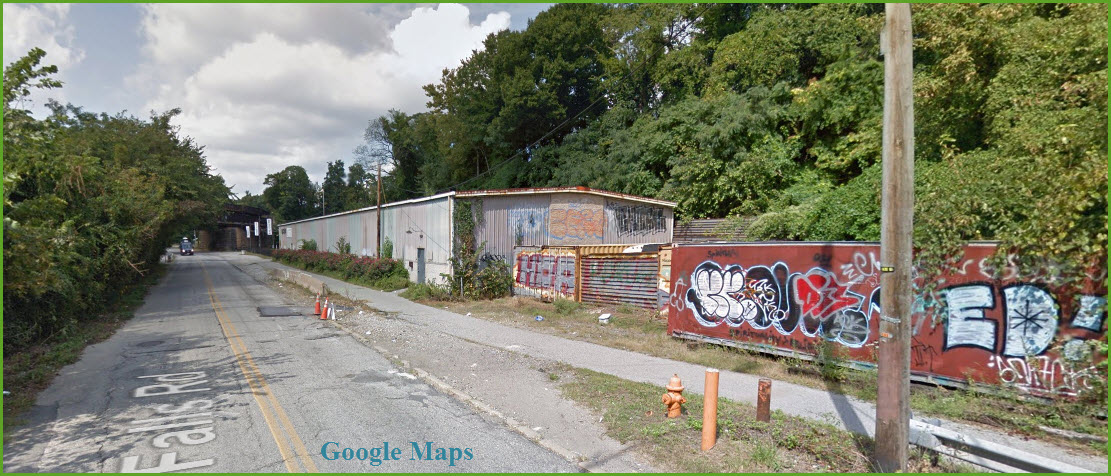
The north end of the carbarn, with the visitors center on the left. The NJT (New Jersey Transit) car and sweeper stand watch over everything.

Another view from a little further north
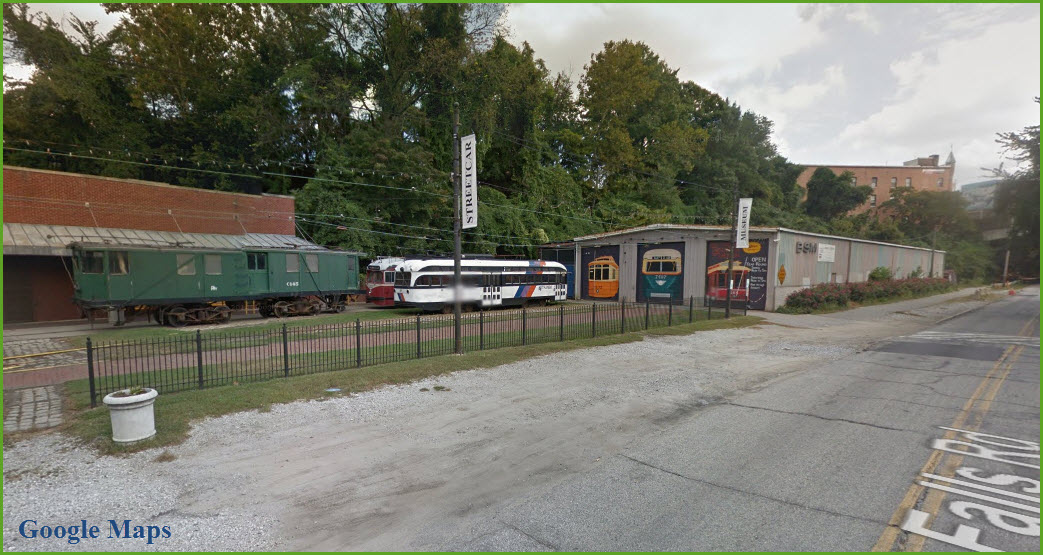
A better view of the visitors center.
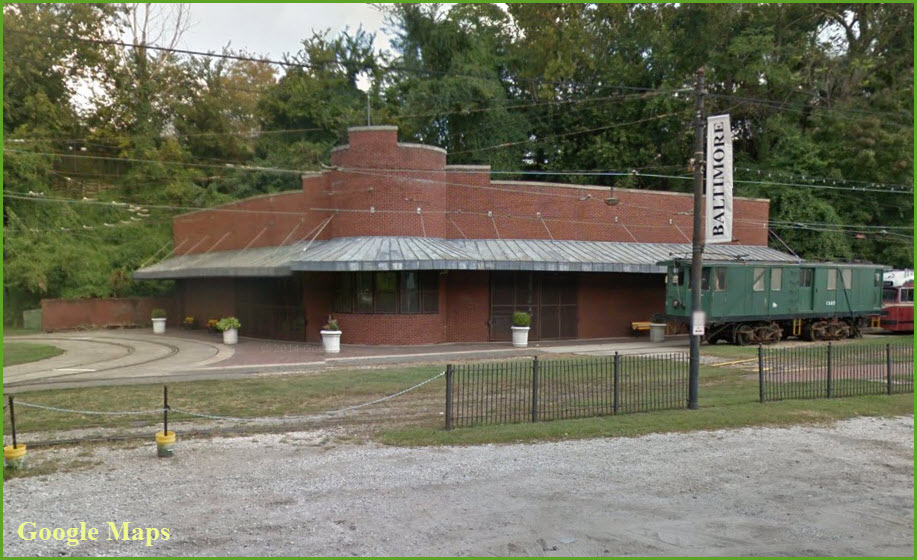
Looking north again from the front of the carbarn, we see the CSX (ex B&O) E-W
mainline through Baltimore. When trains are overhead, streetcars do not run under the bridge.
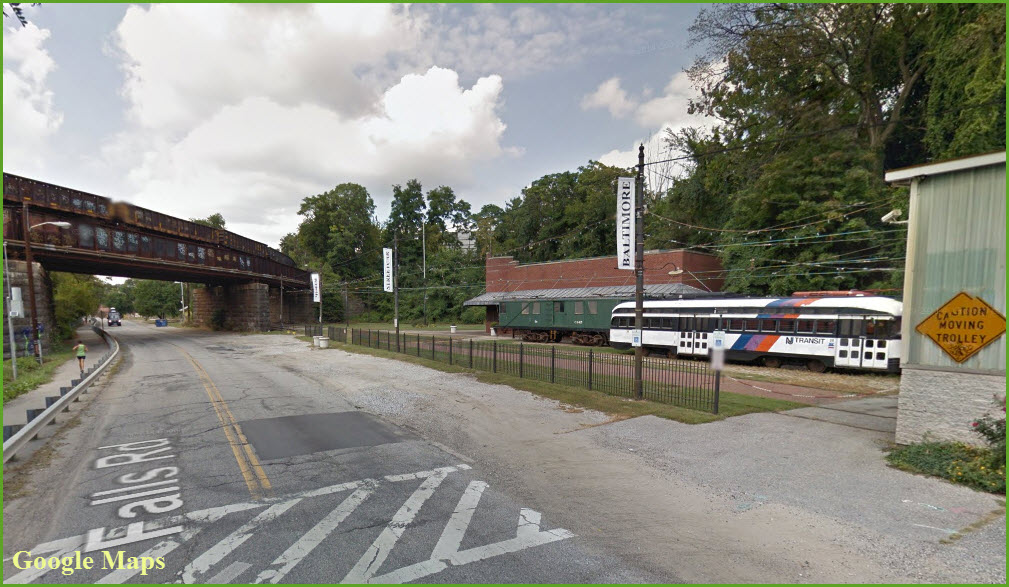
From the other side of the B&O bridge, we can see the sub-station.

A few hundred feet up the track, we approach the ex Ma & Pa (Maryland & Pennsylvania)
warehouse. The old cable car wheel has been a staple here for what, something like 40 years?
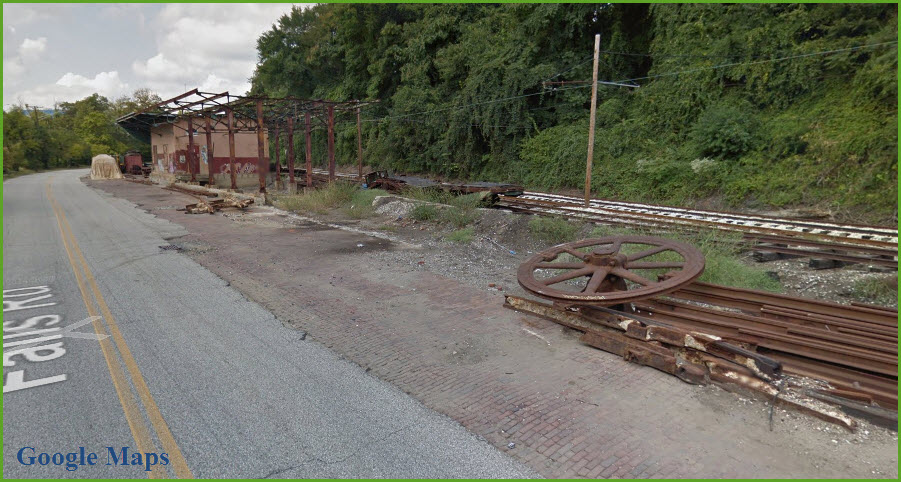
Here you can see the original markings on the side of the warehouse. The museum
uses the warehouse for storage and maintenance, and has pretty much a full shop to do almost anything.
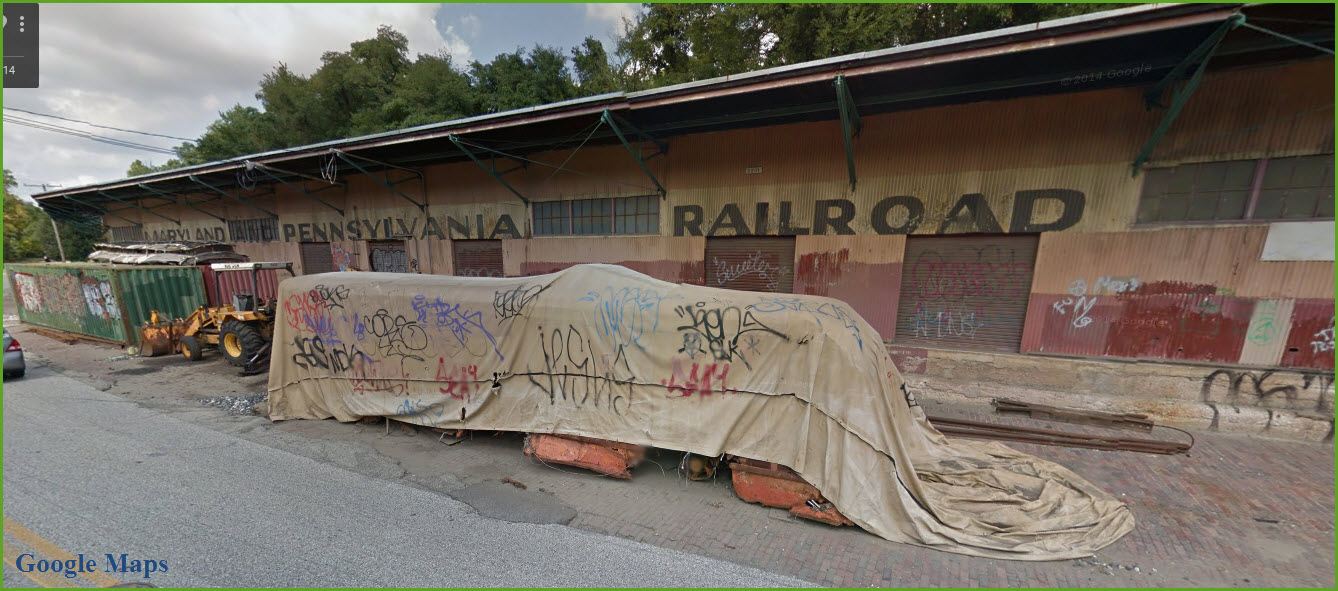
The northern end of the warehouse.
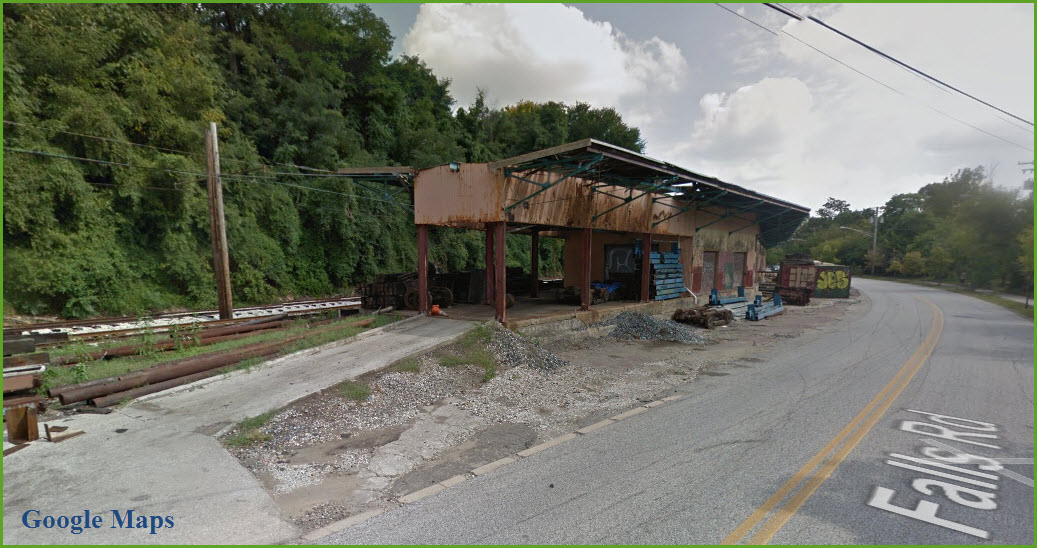
Looking south down the right-of-way, going towards the carbarn and visitors center.
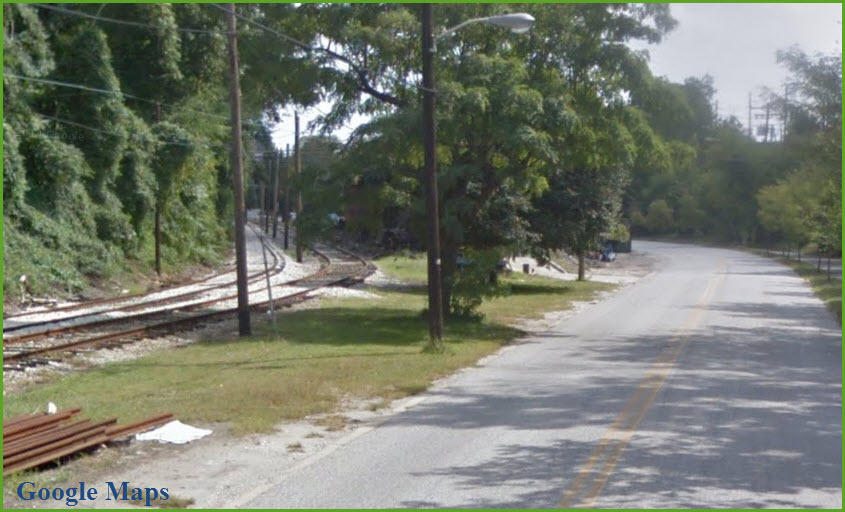
Here is where the double track ends, just before we cross the driveway to the ex Ma & Pa
roundhouse, where the city keeps salt for winter. We have talked to the city about taking over the
roundhouse at some point, but so far, it hasn't happened.
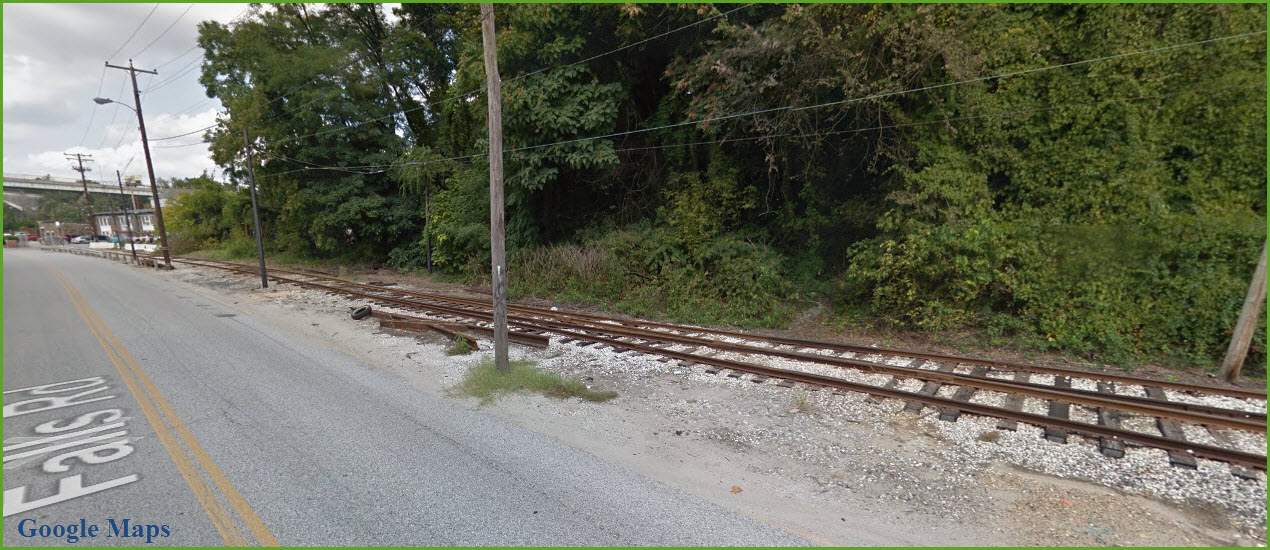
The roundhouse is in relatively good condition considering the Ma & Pa moved out somewhere
around 1964. Streetcars need to stop before crossing the driveway.

Looking south, we can just barely see the Ma & Pa warehouse.

Another shot looking south from the roundhouse.
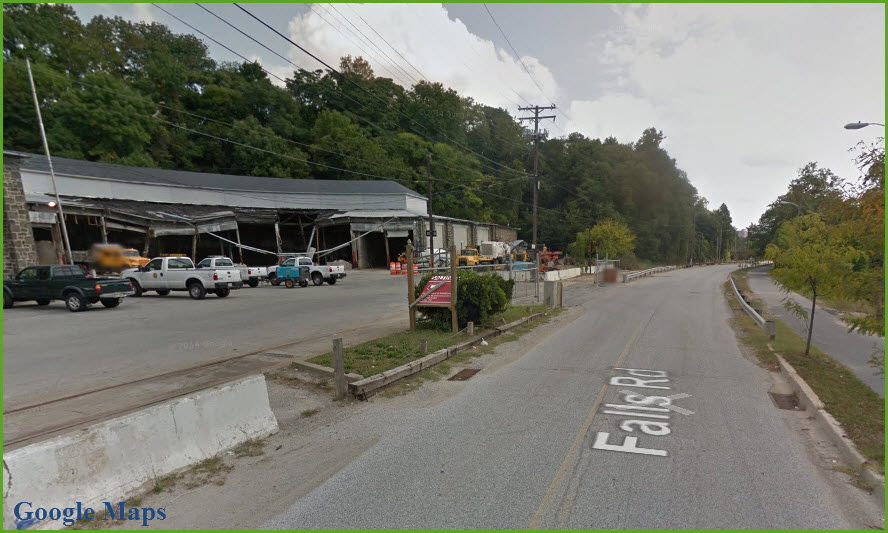
Turning around and looking north again, we approach the north loop, which has two tracks.
That is 28th and 29th Streets going over Falls Road.
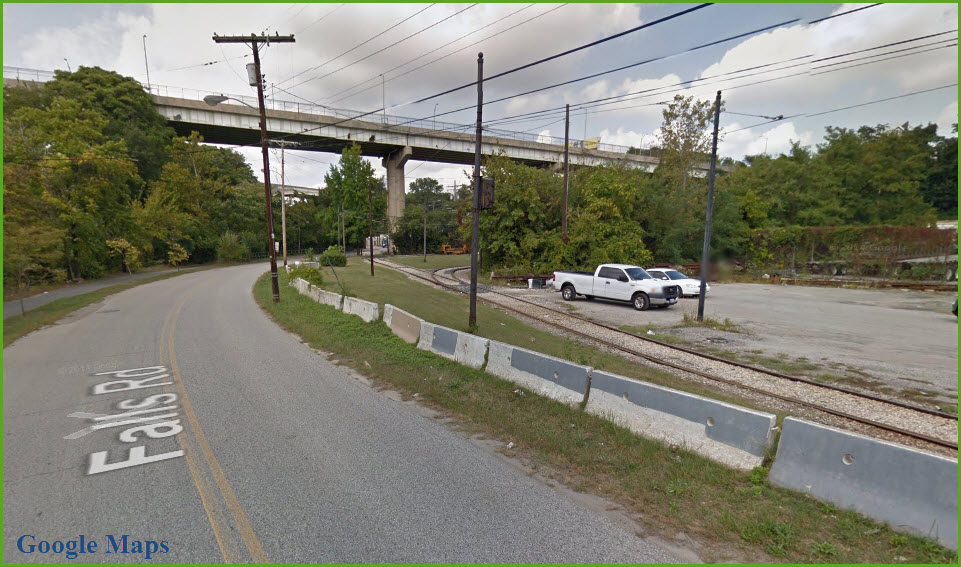
The north loop.

The north loop again.
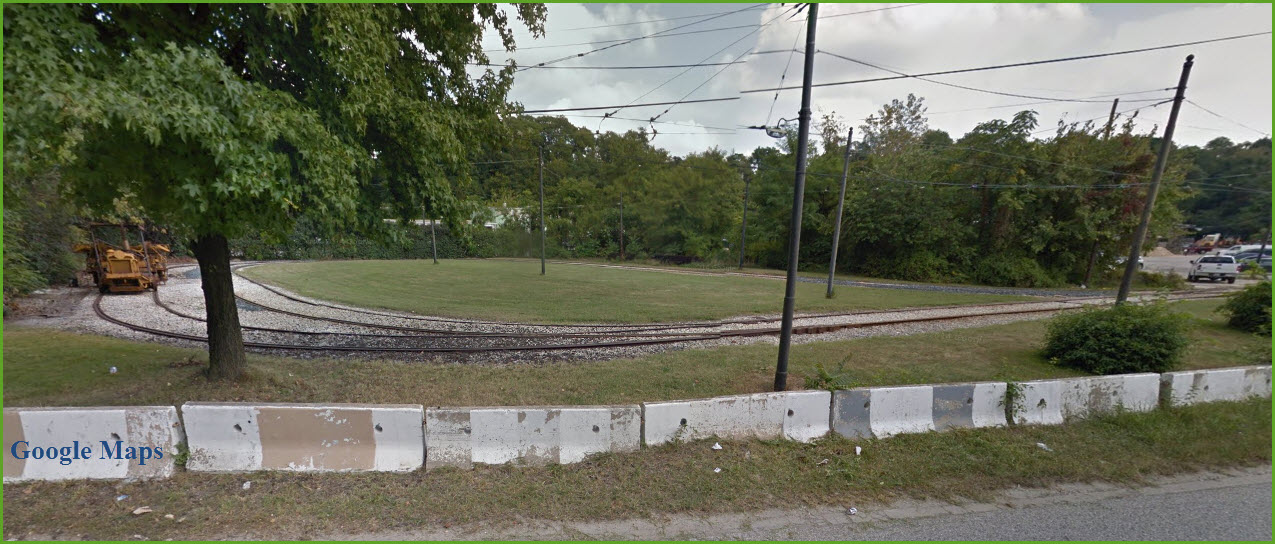
About another quarter mile or so north of the loop, at the Potts & Callahan construction
storage yard, is where the Ma & Pa used to go into a tunnel to climb a small grade to get up into the
Hampden area. The tunnel is still there, but the entrance is covered up on both ends,
and no-one has seen it for years because of P&C.
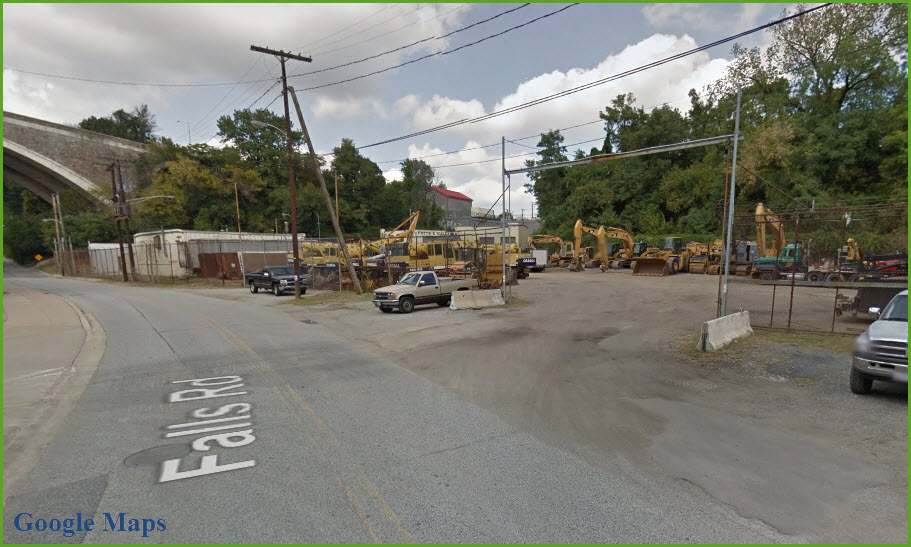
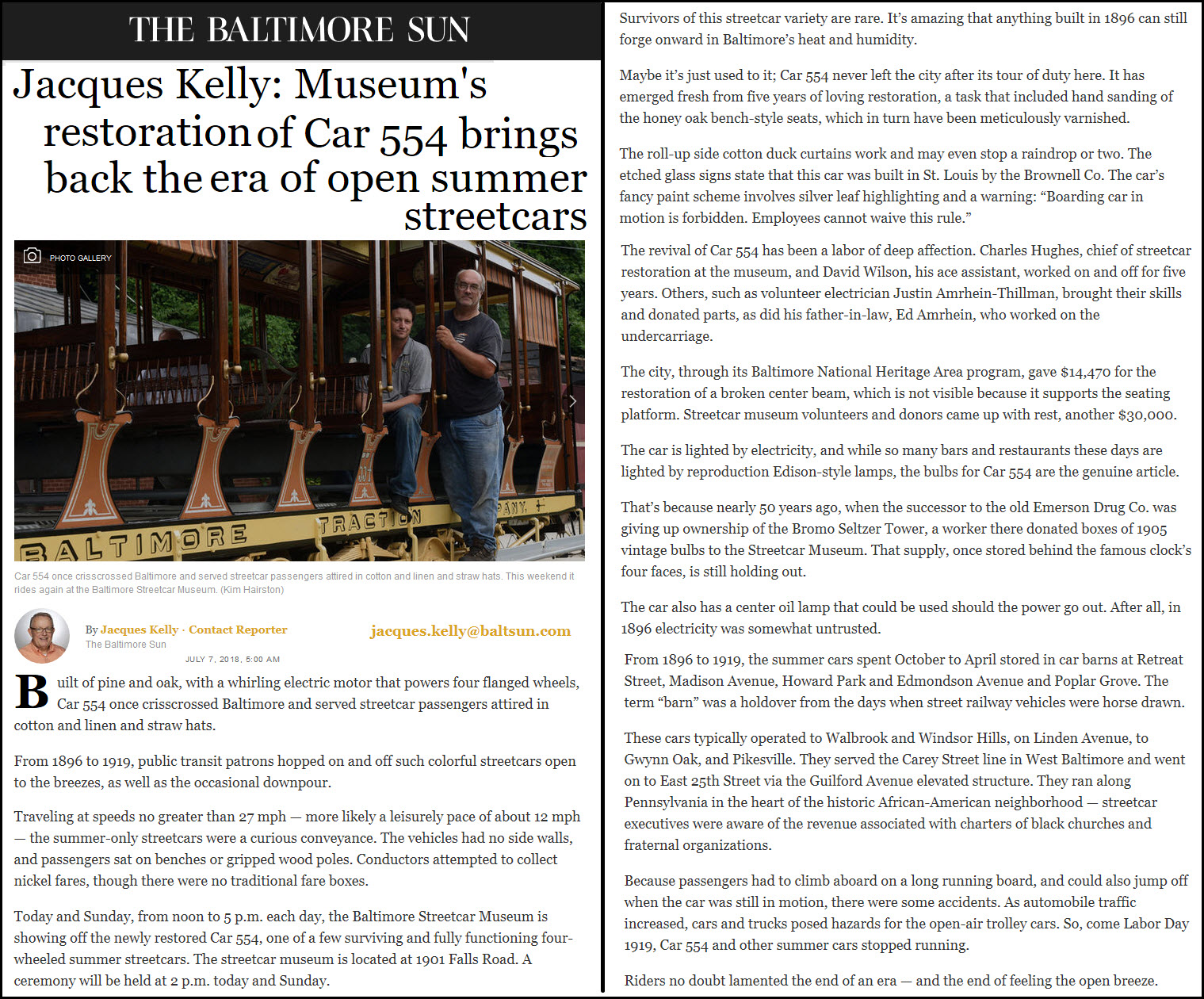
I moved into Ruxton in 1967. From where lived on L'Hirondelle
Club Road, near the top of the hill (7521 on the map), you could see the Pennsy Trains on the Northern Central when the trees were bare. It was
also a time when Lake Roland came all the way up to the L'Hirondelle Club Rd
bridge over Roland Run that fed the lake.
At the time, there was one single car Passenger train coming SB into Baltimore
around 9am. The same train went north leaving Penn Station at 6pm.
The other trains on the line were mostly SB freights coming from Harrisburg.
The NB freights -usually- went up to Harrisburg via the Port Road, leaving
the Northeast Corridor at Perryville MD. This is because the grades on
the Northern Central were a little bit more challenging going north.
Hurricane Agnes in 1972 wiped out too much infrastructure for the bankrupt
Penn Central to rebuild, so from Cockeysville MD north to York PA, the line
was abandoned. The infamous Cockeysville Underpass was covered
over starting in 1990, getting rid of a huge bottleneck on York Road.
Being an outdoorsy type person, I ravaged all over Lake Roland to see what
it offered in the way of fun. Imagine my surprise when I came across the streetcars on the other
side of the Lake. The first time I was there was on a Saturday, when I met
John Engleman. He came back the next day with an
application form, gave him my 17 bucks, and have been a member ever since... maybe not
quite to the participation level they would like, but nevertheless...... (You will see John's name
elsewhere on my two websites, as he is a fountain of knowledge on things I write about :-)
The original intention of the museum was to lay track along the right-of-way of the Northern
Central's Green
Spring Branch. At the time, track was still on the ground from the Green
Spring Branch, having seen its last train in 1962. Track inside the park was sold to the
National Capital Historical Museum of Transportation, and later given to the BSM.
Several years after the cars were removed, the BSM brought in a scrapper to remove almost all but a few hundred
feet of the track, near where the mainline ran (and the light rail is today). The track is still there today!
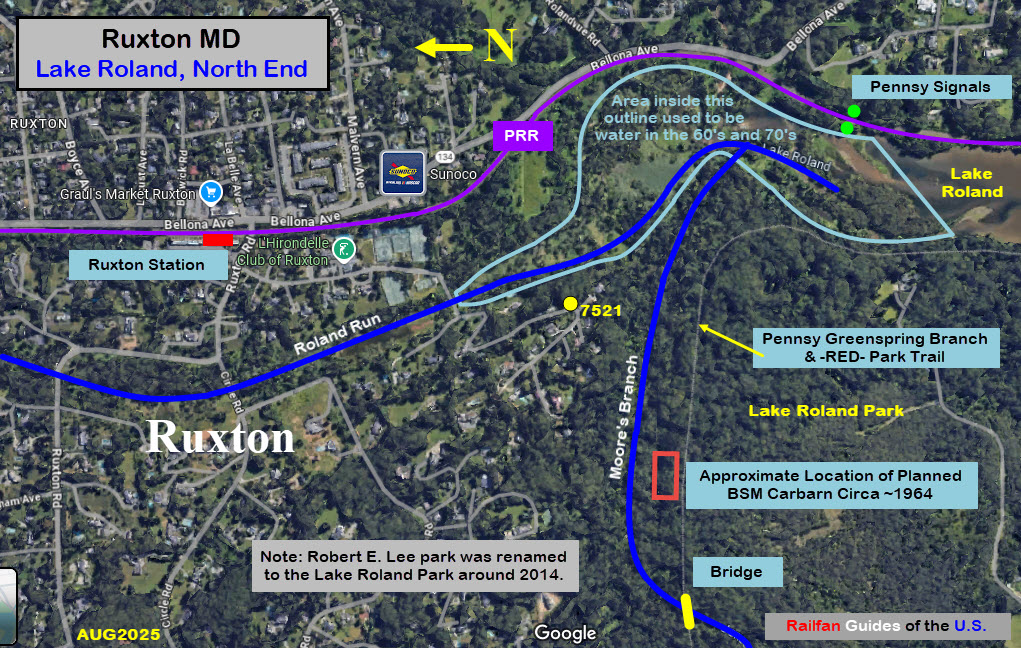
After much negotiation with the City, and having them build a carbarn for the BSM, moving day
came in the summer of 1968. It's a shame, for the ride through the park, along the water,
would have been most beautiful. We can blame a fellow by the name of Guntrum who lived
further up L'Hirondelle Club Road (from where I lived) for the move, for he was politically
well connected, and got the operation shut-down before it even got started. He was
afraid the noise from the museum would bother him and his neighbors.
The pictures below are from just before the move, and one from the weekend after.
Personally, I think they should go for building an extension of the museum up at the Lake.
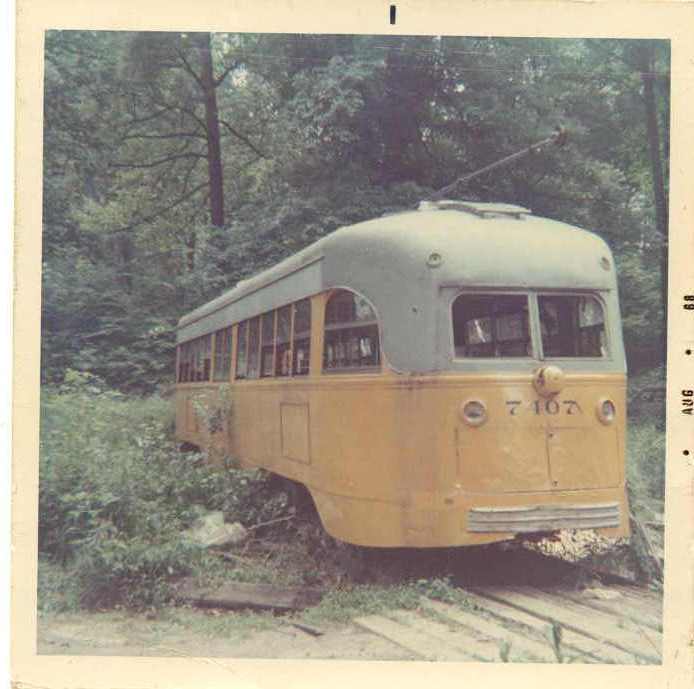
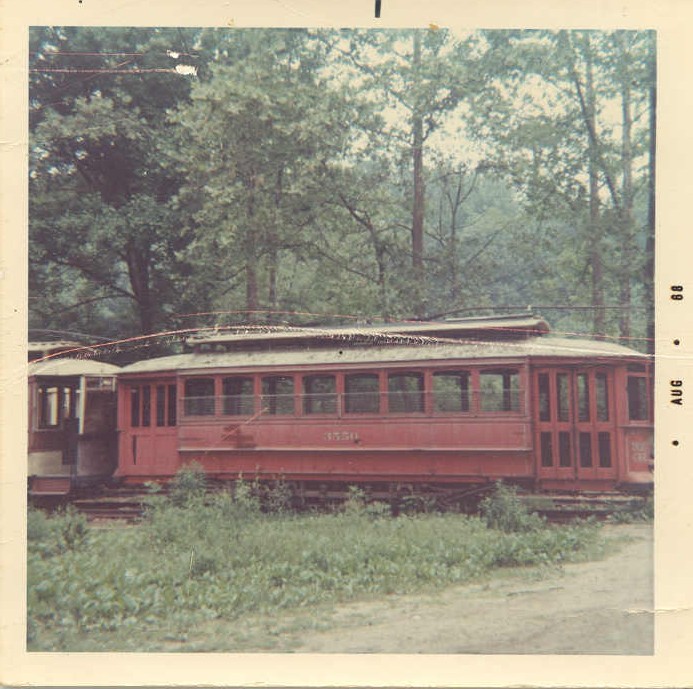
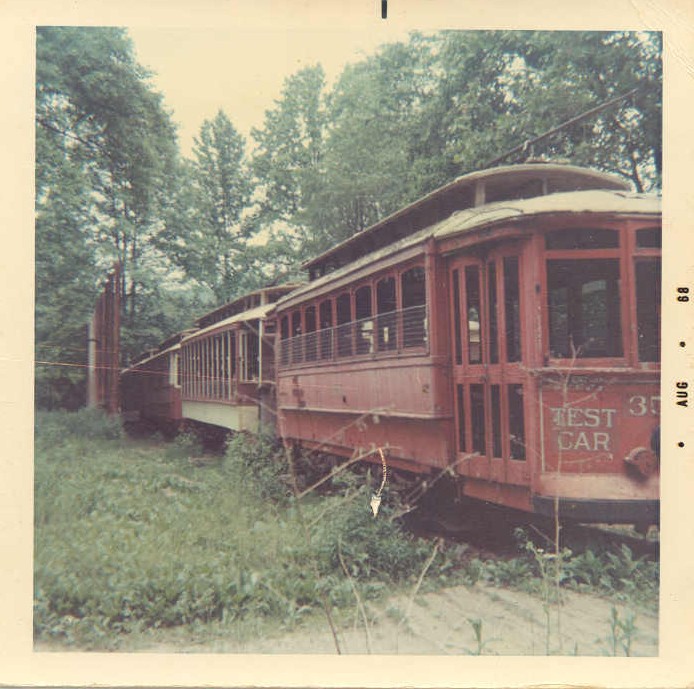
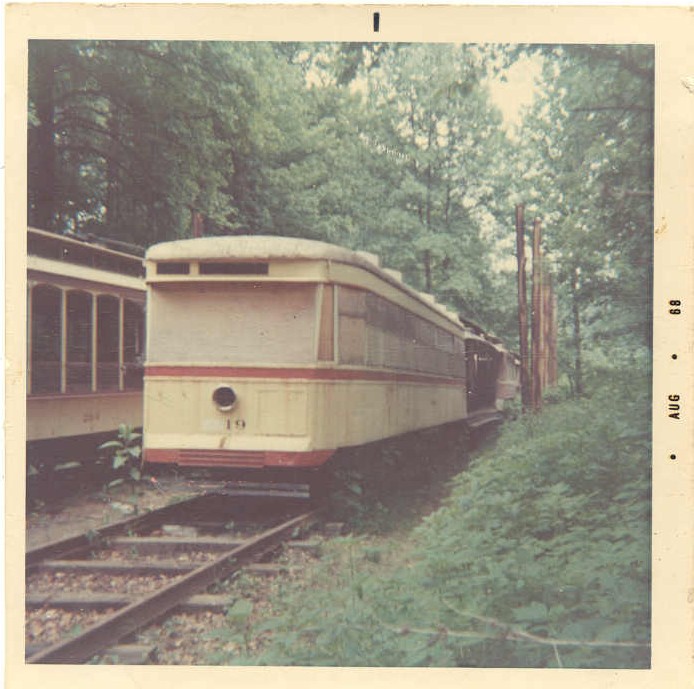
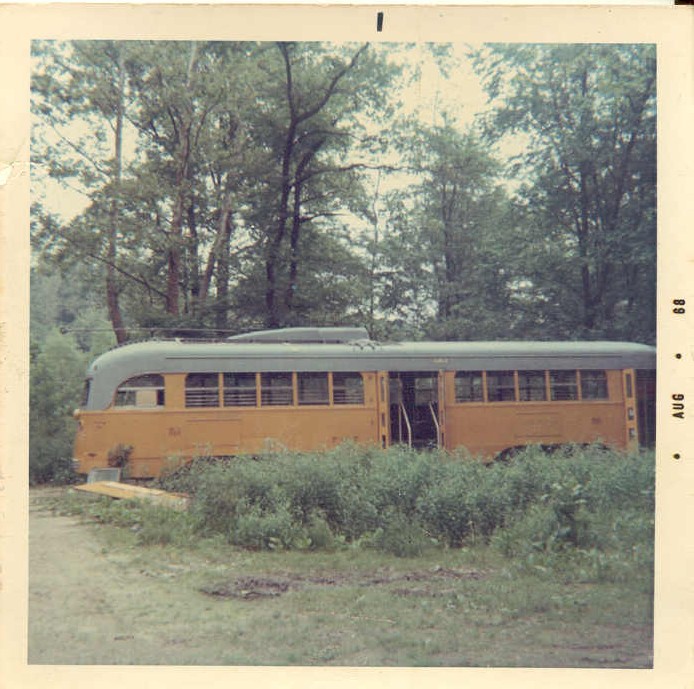
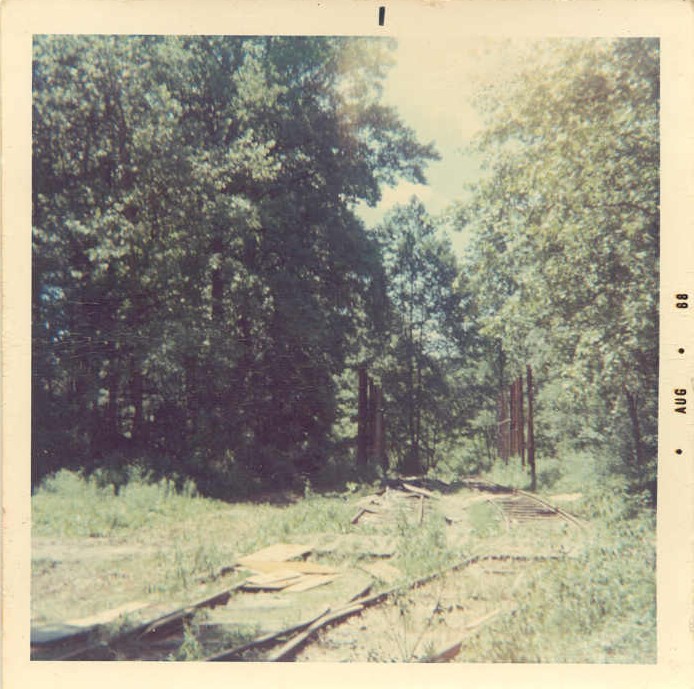
A picture of 4732 at Lake Roland, either being loaded up or taken off of a flatbed. Picture by John Engleman.
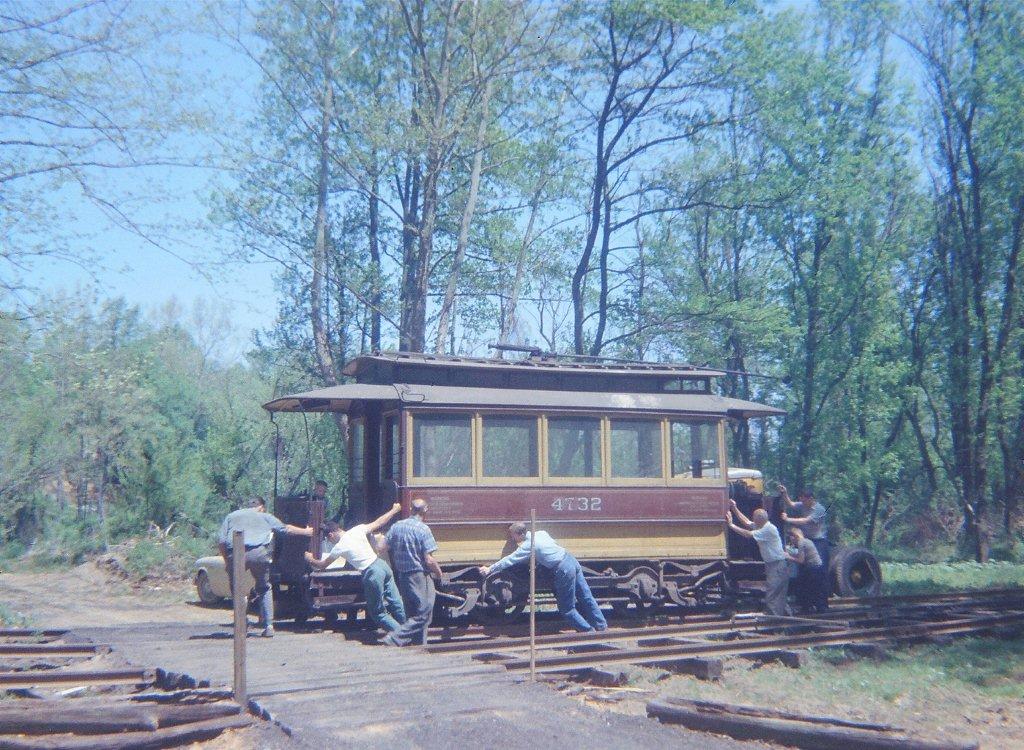
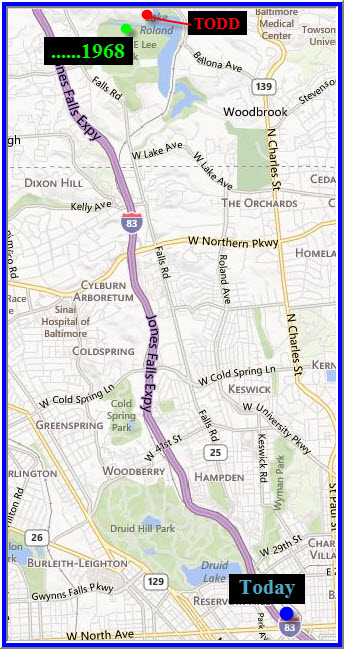
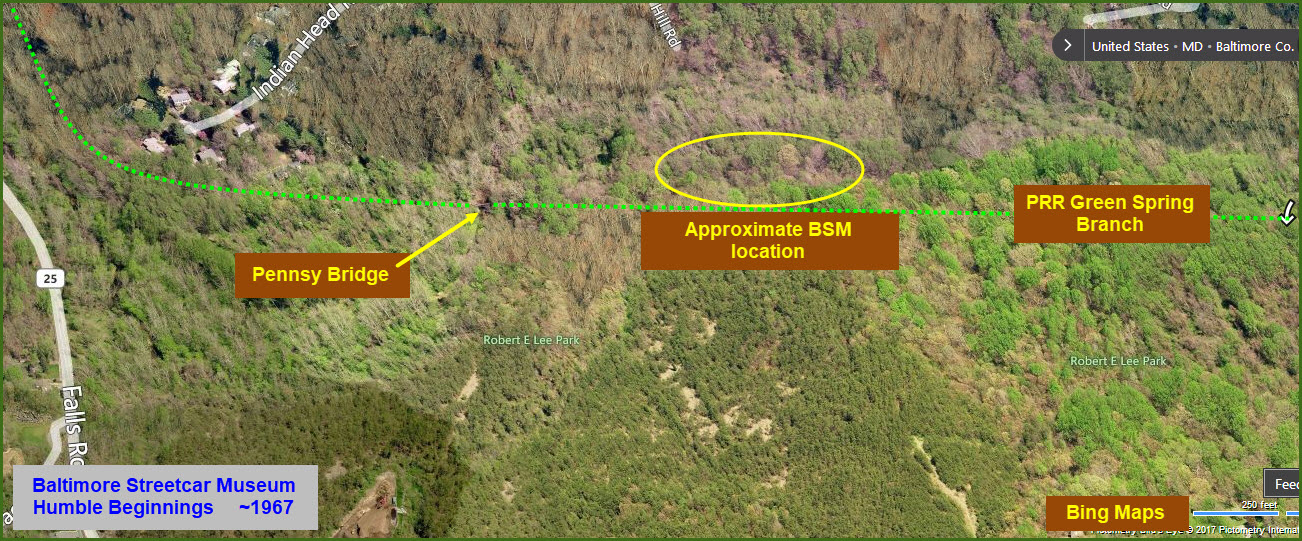
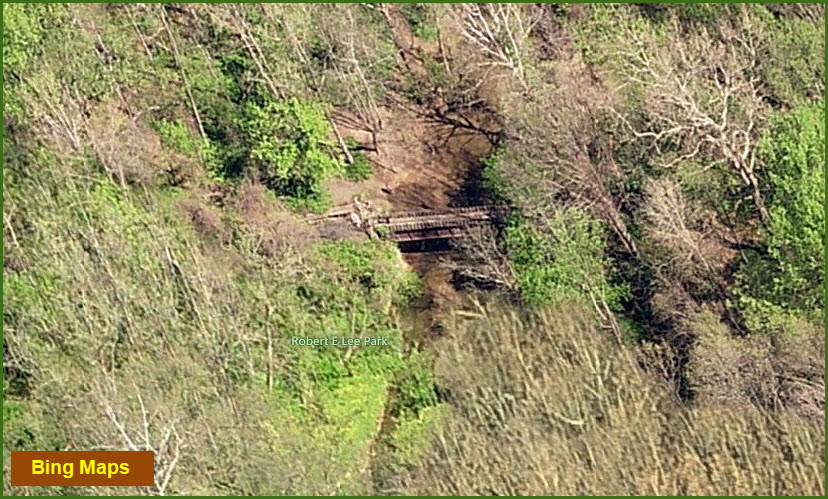 Close up of the Pennsy bridge.
Close up of the Pennsy bridge.
Disclaimers:
New format 10/26/23: Please check out my disclaimer page for my standard
dribble and contact info here
RAILFAN GUIDES HOME
RAILROAD SIGNALS HOME
NEW 11/3/2013, MAY01/2018, AUG03/04/08/2025
Last Modified
08-Aug-2025